Foxes in Retrospect—Unraveling Human-Fox Relationships through Fox Tooth Ornaments in the Swabian Jura
Abstract
1. Introduction
- investigate diachronic changes in technology, production, and function and how these changes relate to the methods of the perforation and mode of use among the three cultures (Aurignacian, Gravettian, and Magdalenian) and within the four analyzed sites in the Swabian Jura,
- explore the potential for species preferences between red fox and arctic fox within the analyzed sites and discuss the results in the framework of fox ecology and behavior, and
- contextualize the results from the Swabian Jura within a broader context, drawing from an extensive literature review of fox tooth ornaments from sites across Europe during the Upper Paleolithic.
Foxes in the Swabian Jura
2. Materials and Methods
2.1. Archaeological and Comparative Materials
2.2. Geometric Morphometric Methods
2.3. Traceological Methods
3. Results
3.1. Geometric-Morphometric Results
3.1.1. Upper Canines
3.1.2. Lower Canines
3.2. Traceological Results
3.2.1. Hohle Fels
Manufacturing Traces
- Scraping/grooving: nine teeth show traces of scraping or grooving, which we define as isolated groups of close, narrow striations, and/or deep grooves (Figure 5a–c). Technological deformations in sectors 1 and 6 of five teeth indicate deep gouging for the purpose of creating an opening in the root (Figure 5a). In three cases, we observed specular lateral deformations in sectors 3 and 9, which we interpret as the result of the widening and smoothing of the perforations through a semi-circular motion with a borer or pointed lithic tool (Figure 5c,d and comparison in the Supplementary Materials and Figure S2g–i). This scraping/grooving technique was always performed bifacially and resulted in elongated perforations on the vertical axis of the root (Figure 5a,c). Interestingly, tooth ID 1228 exhibits bilateral whittling/carving traces complemented by scraping, but it was abandoned during early manufacture before achieving a complete perforation, providing some insight into the order of operations (Figure 5e).
- Drilling: Two teeth (ID 1742 and 461) exhibit clear concentric striations on the inner walls of their perforations, characteristic of the rotating action of a borer or a pointed lithic tool. According to our reference collection, the perforation of tooth ID 461 was created by bifacial free hand drilling (Figure 5f). Tooth ID 1742 was probably bifacially perforated with the use of a bow drill or a hafted hand drill (Figure 5g). The difference between the two techniques is indicated by the high regularity of the drilling traces and the asymmetrical shape of the perforation, which indicates bow drilling. These features may result from the difficulty of controlling a bow drill at high speeds (see for comparison Figure S1h). Only the root surface of ID 461 appears to be prepared by scraping prior to drilling.
Use-Wear Related Traces
3.2.2. Geißenklösterle
Manufacturing Traces
- Scraping/grooving/gouging. Scraping and grooving appeared in eight cases, sometimes combined with gouging. In all cases, this technique was performed bifacially. Scraping is represented by a bundle of close and narrow, long and short striations, while grooving is attested by deep isolated long grooves (Figure 7a–c). In the case of ID 391, the perforation was opened by bifacial gouging and superficial carving of the root, whose traces are evident in sectors 12 and 6 (Figure 7d). The perforations associated with this technique are elongated or sub-oval.
- Drilling. Drilling is attested at Geißenklösterle from only two teeth, both showing traces of scraping to prepare the surface of the root. Clear circular and concentric drilling traces are visible at low and high magnification. The irregularity of the perforations suggests the use of free hand drills (Figure 7e,f). Interestingly, the root of ID 487 is worked in two ways, suggesting two different attachment methods. The root was previously scraped and subsequently drilled in order to obtain a circular hole, which later broke (Figure 7f,g). Underneath the perforation, the root is carved on both lateral sides to create two deep incisions, which might have served to secure a thread (Figure 7f,g). Unfortunately, we could not establish whether the perforation broke ab antiquo or was a result of post-depositional events. Moreover, we were unable to perform observations at higher magnification in search of use-related traces on the carved lateral sides, as the piece could not leave the museum. We thus cannot establish whether the root was carved after the perforation broke to re-facilitate attachment or if it was a stylistic choice.
Use-Wear Related Traces
3.2.3. Hohlenstein-Stadel
Manufacturing Traces
Use-Wear Related Traces
3.2.4. Brillenhöhle
Manufacturing Traces
4. Discussion
4.1. Production of Fox Tooth Ornaments in the Swabian Jura
4.2. Selection of Red versus Arctic Fox
4.3. Fox Tooth Ornaments in the Broader European Context
5. Conclusions
Supplementary Materials
Author Contributions
Funding
Data Availability Statement
Acknowledgments
Conflicts of Interest
References
- Riek, G. Die Eiszeitjägerstation Am Vogelherd Im Lonetal; Akademische Verlagsbuchhandlung Franz F. Heine: Tübingen, Germany, 1934. [Google Scholar]
- Hahn, J. Kraft Und Aggression: Die Botschaft Der Eiszeitkunst Im Aurignacien Süddeutschlands? Archaeologica Venatoria: Tübingen, Germany, 1986; Volume 7, ISBN 978-3-921618-24-0. [Google Scholar]
- Conard, N.J. Palaeolithic Ivory Sculptures from Southwestern Germany and the Origins of Figurative Art. Nature 2003, 426, 830–832. [Google Scholar] [CrossRef]
- Conard, N.J. A Female Figurine from the Basal Aurignacian of Hohle Fels Cave in Southwestern Germany. Nature 2009, 459, 248–252. [Google Scholar] [CrossRef] [PubMed]
- Kölbl, S.; Conard, N.J. (Eds.) Eiszeitschmuck-Status Und Schönheit; Museumsheft; Urgeschichtliches Museum Blaubeuren: Blaubeuren, Germany, 2003; ISBN 1617-2655. [Google Scholar]
- Conard, N.J.; Malina, M. Schmuck Und Vielleicht Auch Musik Am Vogelherd Bei Niederstotzingen-Stetten Ob Lontal, Kreis Heidenheim. Archäol. Ausgrabungen Baden-Württemberg 2005 2006, 21–25. [Google Scholar]
- Conard, N.J.; Malina, M.; Münzel, S.C. New Flutes Document the Earliest Musical Tradition in Southwestern Germany. Nature 2009, 460, 737–740. [Google Scholar] [CrossRef] [PubMed]
- Wolf, S. Schmuckstücke: Die Elfenbeinbearbeitung Im Schwäbischen Aurignacien; Tübingen Monographien zur Urgeschichte; Kerns Verlag: Tübingen, Germany, 2015; ISBN 978-3-935751-21-6. [Google Scholar]
- Dutkiewicz, E. Zeichen: Markierungen, Muster Und Symbole Im Schwäbischen Aurignacien; Tübingen Kerns Verlag: Tübingen, Germany, 2021; ISBN 3-935751-34-6. [Google Scholar]
- White, R. Technological and Social Dimensions of “Aurignacian-Age” Body Ornaments Across Europe. In Before Lascaux: The Complex Record of the Early Upper Paleolithic; Knecht, H., Pike-Tay, A., White, R., Eds.; CRC Press: Boca Raton, FL, USA, 1993; pp. 277–300. [Google Scholar]
- White, R. Systems of Personal Ornamentation in the Early Upper Palaeolithic: Methodological Challenges and New Observations. In Rethinking the Human Revolution: New Behavioural and Biological Perspectives on the Origin and Dispersal of Modern Humans; McDonald Institute Monographs; Mellars, P., Boyle, K., Bar-Yosef, O., Stringer, C., Eds.; McDonald Institute for Archaeological Research: Cambridge, UK, 2007; pp. 287–302. ISBN 1-902937-46-5. [Google Scholar]
- McBrearty, S.; Brooks, A.S. The Revolution That Wasn’t: A New Interpretation of the Origin of Modern Human Behavior. J. Hum. Evol. 2000, 39, 453–563. [Google Scholar] [CrossRef]
- Vanhaeren, M.; d’Errico, F. Aurignacian Ethno-Linguistic Geography of Europe Revealed by Personal Ornaments. J. Archaeol. Sci. 2006, 33, 1105–1128. [Google Scholar] [CrossRef]
- Kuhn, S.L.; Stiner, M.C. Paleolithic Ornaments: Implications for Cognition, Demography and Identity. Diogenes 2007, 54, 40–48. [Google Scholar] [CrossRef]
- Zilhão, J. The Emergence of Ornaments and Art: An Archaeological Perspective on the Origins of “Behavioral Modernity”. J. Archaeol. Res. 2007, 15, 1–54. [Google Scholar] [CrossRef]
- D’Errico, F.; Vanhaeren, M. Earliest Personal Ornaments and Their Significance for the Origin of Language Debate. In The Cradle of Language; Studies in the Evolution of Language; Sands, B., Güldemann, T., Eds.; Oxford University Press: Oxford, UK, 2009; pp. 204–218. [Google Scholar]
- Trinkaus, E.; Buzhilova, A.P. Diversity and Differential Disposal of the Dead at Sunghir. Antiquity 2018, 92, 7–21. [Google Scholar] [CrossRef]
- White, R. Beyond Art: Toward an Understanding of the Origins of Material Representation in Europe. Annu. Rev. Anthropol. 1992, 21, 537–564. [Google Scholar] [CrossRef]
- White, R. Substantial Acts: Meaning in Upper Paleolithic Representation. In Beyond Art: Pleistocene Image and Symbol; Wattis Symposium Series in Anthropology; Conkey, M.W., Soffer, O., Stratmann, D., Jablonski, N.C., Eds.; University of California Press: San Francisco, CA, USA, 1997; pp. 93–121. [Google Scholar]
- White, R. Personal Ornaments from the Grotte Du Renne at Arcy-Sur-Cure. Athena Rev. 2001, 2, 41–46. [Google Scholar]
- Stiner, M.C. “Standardization” in Upper Paleolithic Ornaments at the Coastal Sites of Riparo Mochi and Üçagızlı Cave. In The Chronology of the Aurignacian and of the Transitional Technocomplexes: Dating, Stratigraphies, Cultural Implications; Trabalhos de Arqueologia; Zilhão, J., D’errico, F., Eds.; Instituto Português de Arqueologia: Lisboa, Portugal, 2003. [Google Scholar]
- Stiner, M. Finding a Common Bandwidth: Causes of Convergence and Diversity in Paleolithic Beads. Biol. Theory 2014, 9, 51–64. [Google Scholar] [CrossRef]
- Heckel, C. Physical Characteristics of Mammoth Ivory and Their Implications for Ivory Work in the Upper Paleolithic. Mitteilungen Der Ges. Für Urgesch. 2009, 18, 71–91. [Google Scholar]
- Cristiani, E.; Farbstein, R.; Miracle, P. Ornamental Traditions in the Eastern Adriatic: The Upper Palaeolithic and Mesolithic Personal Adornments from Vela Spila (Croatia). J. Anthropol. Archaeol. 2014, 36, 21–31. [Google Scholar] [CrossRef]
- White, R.; Normand, C. Early and Archaic Aurignacian Personal Ornaments from Isturitz Cave: Technological and Regional Perspectives. Palethnol. Archéol. Et Sci. Hum. 2015, 7|2015. Available online: http://journals.openedition.org/palethnologie/789 (accessed on 12 September 2023). [CrossRef]
- Wolf, S.; Conard, N.J. Personal Ornaments of the Swabian Aurignacian. Palethnol. Archéol. Et Sci. Hum. 2015, 7|2015. Available online: http://journals.openedition.org/palethnologie/897 (accessed on 12 September 2023). [CrossRef]
- Wolf, S.; Heckel, C. Ivory Ornaments of the Aurignacian in Western Europe: Case Studies from France and Germany. L’Anthropologie 2018, 122, 348–373. [Google Scholar] [CrossRef]
- Peresani, M.; Forte, M.; Quaggiotto, E.; Colonese, A.C.; Romandini, M.; Cilli, C.; Giacobini, G. Marine and Freshwater Shell Exploitation in the Early Upper Paleolithic: Re-Examination of the Assemblages from Fumane Cave (NE Italy). PaleoAnthropology 2019, 2019, 64–81. [Google Scholar]
- Stiner, M.C.; Kuhn, S.L.; Güleç, E. Early Upper Paleolithic Shell Beads at Üçağızlı Cave I (Turkey): Technology and the Socioeconomic Context of Ornament Life-Histories. J. Hum. Evol. 2013, 64, 380–398. [Google Scholar] [CrossRef]
- Tátá, F.; Cascalheira, J.; Marreiros, J.; Pereira, T.; Bicho, N. Shell Bead Production in the Upper Paleolithic of Vale Boi (SW Portugal): An Experimental Perspective. J. Archaeol. Sci. 2014, 42, 29–41. [Google Scholar] [CrossRef]
- Álvarez-Fernández, E. Los Objetos de Adorno-Colgantes Del Paleolítico Superior y Del Mesolítico En La Cornisa Cantábrica y En El Valle Del Ebro: Una Visión Europea. Ph.D. Dissertation, Universidad de Salamanca, Salamanca, Spain, 2006. [Google Scholar]
- Trinkaus, E.; Svoboda, J.A.; Wojtal, P.; Fišákova, M.N.; Wilczyński, J. Human Remains from the Moravian Gravettian: Morphology and Taphonomy of Additional Elements from Dolní Vĕstonice II and Pavlov I. Int. J. Osteoarchaeol. 2010, 20, 645–669. [Google Scholar] [CrossRef]
- Trinkaus, E.; Buzhilova, A.P.; Mednikova, M.B.; Dobrovolskaya, M.V. The People of Sunghir: Burials, Bodies, and Behavior in the Earlier Upper Paleolithic; Human Evolution Series; Oxford University Press: Oxford, UK, 2014; ISBN 978-0-19-938105-0. [Google Scholar]
- Wojtal, P.; Wilczyński, J.; Bocheński, Z.M.; Svoboda, J.A. The Scene of Spectacular Feasts: Animal Remains from Pavlov I South-East, the Czech Republic. Quat. Int. 2012, 252, 122–141. [Google Scholar] [CrossRef]
- Niven, L. The Palaeolithic Occupation of Vogelherd Cave: Implications for the Subsistence Behavior of Late Neanderthals and Early Modern Humans; Tübingen Publications in Prehistory; Kerns Verlag: Tübingen, Germany, 2006; ISBN 978-3-935751-04-9. [Google Scholar]
- Kitagawa, K.; Krönneck, P.; Conard, N.J.; Münzel, S. Exploring Cave Use and Exploitation Among Cave Bears, Carnivores and Hominins in the Swabian Jura, Germany. J. Taphon. 2012, 10, 439–461. [Google Scholar]
- Conard, N.J.; Kitagawa, K.; Krönneck, P.; Böhme, M.; Münzel, S. The Importance of Fish, Fowl and Small Mammals in the Paleolithic Diet of the Swabian Jura, Southwestern Germany. In Vertebrate Paleobiology and Paleoanthropology; Springer Science: Dordrecht, The Netherlands, 2013; pp. 173–190. ISBN 978-94-007-6765-2. [Google Scholar]
- Baumann, C.; Bocherens, H.; Drucker, D.G.; Conard, N.J. Fox Dietary Ecology as a Tracer of Human Impact on Pleistocene Ecosystems. PLoS ONE 2020, 15, e0235692. [Google Scholar] [CrossRef] [PubMed]
- Münzel, S.C. Die Jungpleistozäne Großsäugerfauna Aus Dem Geißenklösterle. In Geißenklösterle II. Chronostratigraphie, Paläoumwelt und Subsistenz im Mittel- und Jungpaläolithikum der Schwäbischen Alb; Conard, N.J., Bolus, M., Münzel, S.C., Eds.; Kerns Verlag: Tübingen, Germany, 2019; p. 416. [Google Scholar]
- Hofreiter, M.; Stewart, J. Ecological Change, Range Fluctuations and Population Dynamics during the Pleistocene. Curr. Biol. 2009, 19, R584–R594. [Google Scholar] [CrossRef]
- Pushkina, D.; Raia, P. Human Influence on Distribution and Extinctions of the Late Pleistocene Eurasian Megafauna. J. Hum. Evol. 2008, 54, 769–782. [Google Scholar] [CrossRef]
- Sommer, R.; Benecke, N. Late-Pleistocene and Early Holocene History of the Canid Fauna of Europe (Canidae). Mamm. Biol. 2005, 70, 227–241. [Google Scholar] [CrossRef]
- Sommer, R.S.; Nadachowski, A. Glacial Refugia of Mammals in Europe: Evidence from Fossil Records. Mammal Rev. 2006, 36, 251–265. [Google Scholar] [CrossRef]
- Baumann, C.; Wong, G.L.; Starkovich, B.M.; Münzel, S.C.; Conard, N.J. The Role of Foxes in the Palaeolithic Economies of the Swabian Jura (Germany). Archaeol. Anthropol. Sci. 2020, 12, 1–17. [Google Scholar] [CrossRef]
- Stiner, M.C.; Munro, N.D.; Surovell, T.A. The Tortoise and the Hare: Small-Game Use, the Broad-Spectrum Revolution, and Paleolithic Demography. Curr. Anthropol. 2000, 41, 39–79. [Google Scholar] [CrossRef]
- Kitagawa, K. Exploring Hominins and Animals in the Swabian Jura: Study of the Paleolithic Fauna from Hohlenstein-Stadel. Ph.D. Thesis, Universität Tübingen, Tübingen, Germany, 2014. [Google Scholar]
- Wong, G.L.; Starkovich, B.M.; Drucker, D.G.; Conard, N.J. New Perspectives on Human Subsistence during the Magdalenian in the Swabian Jura, Germany. Archaeol. Anthropol. Sci. 2020, 12, 217. [Google Scholar] [CrossRef]
- Krönneck, P. Die Pleistozäne Makrofauna Des Bocksteins (Lonetal-Schwäbische Alb) Ein Neuer Ansatz Zur Rekonstruktion Der Paläoumwelt. Ph.D. Thesis, Universität Tübingen, Tübingen, Germany, 2012. [Google Scholar]
- Boger, U.; Starkovich, B.M.; Conard, N.J. New insights gained from the faunal material recovered during the latest excavations at Vogelherd Cave. Mitteilungen Ges. Urgesch. 2014, 23, 57–81. [Google Scholar]
- Niven, L. From Carcass to Cave: Large Mammal Exploitation during the Aurignacian at Vogelherd, Germany. J. Hum. Evol. 2007, 53, 362–382. [Google Scholar] [CrossRef] [PubMed]
- Napierala, H.; Münzel, S.C.; Conard, N.J. Die Fauna Des Magdalénien Vom Hohle Fels. In Das Magdalénien des Hohle Fels. Chronologische Stellung, Lithische Technologie und Funktion der Rückenmesser; Tübinger Monographien zur Urgeschichte; Kerns Verlag: Tübingen, Germany, 2014; pp. 275–317. [Google Scholar]
- Wong, G.L.; Starkovich, B.M.; Conard, N.J. Human Subsistence and Environment during the Magdalenian at Langmahdhalde: Evidence from a New Rock Shelter in the Lone Valley, Southwest Germany. Mitteliungen Der Ges. Für Urgesch. 2017, 26, 103–123. [Google Scholar]
- Camarós, E.; Münzel, S.C.; Cueto, M.; Rivals, F.; Conard, N.J. The Evolution of Paleolithic Hominin–Carnivore Interaction Written in Teeth: Stories from the Swabian Jura (Germany). J. Archaeol. Sci. Rep. 2016, 6, 798–809. [Google Scholar] [CrossRef]
- Baumann, C. The Paleo-Synanthropic Niche: A First Attempt to Define Animal’s Adaptation to a Human-Made Micro-Environment in the Late Pleistocene. Archaeol. Anthropol. Sci. 2023, 15, 63. [Google Scholar] [CrossRef]
- Baumann, C.; Starkovich, B.M.; Drucker, D.G.; Münzel, S.C.; Conard, N.J.; Bocherens, H. Dietary Niche Partitioning among Magdalenian Canids in Southwestern Germany and Switzerland. Quat. Sci. Rev. 2020, 227, 106032. [Google Scholar] [CrossRef]
- Conard, N.J.; Malina, M. Die Ausgrabungen Am Hohle Fels Bei Schelklingen, Alb-Donau-Kreis. Archäol. Ausgrabungen Baden-Württemberg 2007, 2006, 17–21. [Google Scholar]
- Conard, N.J.; Malina, M. New Evidence for the Origins of Music from the Caves of the Swabian Jura. Orient Archäol. 2008, 22, 13–22. [Google Scholar]
- Conard, N.J.; Malina, M. Die Ausgrabungen 2004 in Den Frühen Jungpaläolithischen Schichten Des Hohle Fels Bei Schelklingen, Alb-Donau-Kreis. pro Ano. Archäol. Ausgrabungen Baden-Württemberg 2005, 2004, 17–21. [Google Scholar]
- Conard, N.J.; Janas, A.; Malina, M. Vielfältige Funde Aus Dem Aurignacien Und Ein Bemalter Stein Aus Dem Magdalénien Vom Hohle Fels Bei Schelklingen. Archäol. Ausgrabungen Baden-Württemberg 2014, 2013, 58–63. [Google Scholar]
- Hahn, J. (Ed.) Die Geißenklösterle-Höhle Im Achtal Bei Blaubeuren I: Fundhorizontbildung Und Besiedlung Im Mittelpaläolithikum Und Im Aurignacien; Forschungen und Berichte zur Vor- und Frühgeschichte in Baden-Württemberg; Theiss Verlag: Stuttgart, Germany, 1988; ISBN 3-8062-0794-1. [Google Scholar]
- Hahn, J. Besiedlung Und Tätigkeit Im Aurignacien Des Hohlenstein-Stadels. In Die altsteinzeitliche Elfenbeinstatuette aus der Höhle Stadel im Hohlenstein bei Asselfingen, Alb-Donau-Kreis; Fundberichte aus Baden-Württemberg: Baden-Württemberg, Germany, 1989; Volume 14, pp. 97–118. [Google Scholar]
- Hahn, J. Nachgrabungen Im Hohlen Felsen Bei Schelklingen, Alb-Donau-Kreis. Archäol. Korresp. 1977, 7, 241–248. [Google Scholar]
- Wolf, S. Schmuck aus den neuen Ausgrabungen. In Löwenmensch und mehr: Die Ausgrabungen 2008–2013 in Den Altsteinzeitlichen Schichten der Stadel-Höhle im Hohlenstein (Lonetal), Gemeinde Asselfingen, Alb-Donau-Kreis; Forschungen und Berichte zur Archäologie in Baden-Württembrg; Kind, C.-J., Ed.; Reichert Verlag: Wiesbaden, Germany, 2019; pp. 125–128. [Google Scholar]
- Reinhardt, B.; Wehrberger, K. Der Löwenmensch; Ulmer Museum: Ulm, Germany, 2005; ISBN 3-928738-04-6. [Google Scholar]
- Kind, C.-J.; Ebinger-Rist, N.; Wolf, S.; Beutelspacher, T.; Wehrberger, K. The Smile of the Lion Man. Recent Excavations in Stadel Cave (Baden-Württemberg, South-Western Germany) and the Restoration of the Famous Upper Palaeolithic Figurine-Das Lächeln Des Löwenmenschen. Neue Ausgrabungen in Der Stadel-Höhle (Baden-Württemberg, Südwestdeutschland) Und Die Restaurierung Der Berühmten Jungpaläolithischen Figur. Quartär–Int. Jahrb. Zur Erforsch. Des Eiszeitalt. Und Der Steinzeit 2014, 61, 129–145. [Google Scholar]
- Benazzi, S.; Fornai, C.; Buti, L.; Toussaint, M.; Mallegni, F.; Ricci, S.; Gruppioni, G.; Weber, G.W.; Condemi, S.; Ronchitelli, A. Cervical and Crown Outline Analysis of Worn Neanderthal and Modern Human Lower Second Deciduous Molars. Am. J. Phys. Anthropol. 2012, 149, 537–546. [Google Scholar] [CrossRef] [PubMed]
- Röding, C.; Zastrow, J.; Scherf, H.; Doukas, C.; Harvati, K. Crown Outline Analysis of the Hominin Upper Third Molar from the Megalopolis Basin, Peloponnese, Greece. In Ancient connections in Eurasia; Kerns Verlag: Tübingen, Germany, 2021. [Google Scholar]
- Bauer, C.C.; Benazzi, S.; Darlas, A.; Harvati, K. Geometric Morphometric Analysis and Internal Structure Measurements of the Neanderthal Lower Fourth Premolars from Kalamakia, Greece. Quat. Int. 2018, 497, 14–21. [Google Scholar] [CrossRef]
- Harvati, K.; Bauer, C.C.; Grine, F.E.; Benazzi, S.; Ackermann, R.R.; van Niekerk, K.L.; Henshilwood, C.S. A Human Deciduous Molar from the Middle Stone Age (Howiesons Poort) of Klipdrift Shelter, South Africa. J. Hum. Evol. 2015, 82, 190–196. [Google Scholar] [CrossRef]
- Adams, D.; Collyer, M.; Kaliontzopoulou, A.; Baken, E. Geomorph: Geometric Morphometric Analyses of 2D and 3D Landmark Data 2021. Available online: https://cran.r-project.org/web/packages/geomorph/index.html (accessed on 30 February 2022).
- Baken, E.K.; Collyer, M.L.; Kaliontzopoulou, A.; Adams, D.C. Geomorph v4.0 and GmShiny: Enhanced Analytics and a New Graphical Interface for a Comprehensive Morphometric Experience. Methods Ecol. Evol. 2021, 12, 2355–2363. [Google Scholar] [CrossRef]
- Wickham, H. Ggplot2: Elegant Graphics for Data Analysis; Springer: New York, NY, USA, 2016. [Google Scholar]
- Kassambara, A. Ggpubr: “ggplot2” Based Publication Ready Plots 2023. Available online: https://cran.r-project.org/web/packages/ggpubr/index.html (accessed on 21 May 2023).
- Slowikowski, K. Ggrepel: Automatically Position Non-Overlapping Text Labels with “Ggplot2”. R Package Version 0.9.1. 2021. Available online: https://CRAN.R-Project.Org/Package=ggrepel (accessed on 21 May 2023).
- Bollen, K.A.; Jackman, R.W. Regression Diagnostics: An Expository Treatment of Outliers and Influential Cases. Sociol. Methods Res. 1985, 13, 510–542. [Google Scholar] [CrossRef]
- Keeley, L.H. Experimental Determination of Stone Tool Uses: A Microwear Analysis; University of Chicago Press: Chicago, IL, USA, 1980; ISBN 978-0-226-42889-5. [Google Scholar]
- Semenov, S.A. Prehistoric Technology: An Experimental Study of the Oldest Tools and Artefacts from Traces of Manufacture and Wear; Cory, Adams & Mackay: London, UK, 1964; ISBN 978-0-389-20571-5. [Google Scholar]
- Van Gijn, A.L. The Wear and Tear of Flint. Principles of Functional Analysis Applied to Dutch Neolithic Assemblages; Analecta Praehistorica Leidensia; Leiden University: Leiden, The Netherlands, 1990; ISBN 978-90-73368-02-6. [Google Scholar]
- Sidéra, I.; Legrand, A. Tracéologie Fonctionnelle Des Matières Osseuses: Une Méthode. Bull. De La Soc. Préhist. Française 2006, 103, 291–304. [Google Scholar] [CrossRef]
- Buc, N. Experimental Series and Use-Wear in Bone Tools. J. Archaeol. Sci. 2011, 38, 546–557. [Google Scholar] [CrossRef]
- Vaughan, P. Use-Wear Analysis of Flaked Stone Tools; University of Arizona Press: Tucson, AZ, USA, 1985; ISBN 978-0-8165-0861-7. [Google Scholar]
- Osipowicz, G.; Piličiauskienė, G.; Orłowska, J.; Piličiauskas, G. An Occasional Ornament, Part of Clothes or Just a Gift for Ancestors? The Results of Traceological Studies of Teeth Pendants from the Subneolithic Sites in Šventoji, Lithuania. J. Archaeol. Sci. Rep. 2020, 29, 102130. [Google Scholar] [CrossRef]
- Mărgărit, M.; Boroneanț, A.; Bonsall, C. Stone and Osseous Adornments in the Mesolithic and Early Neolithic of the Iron Gates. Open Archaeol. 2021, 7, 779–797. [Google Scholar] [CrossRef]
- Chauvière, F.-X.; Castel, J.-C. Le Statut Du Renard à Combe Saunière (Sarliac-Sur-l’Isle, Dordogne) et Dans Le Solutréen de l’Est Aquitain. In Petits Animaux et Sociétés Humaines. Du Complément Alimentaire aux Ressources Utilitaires. XXIVè Rencontres Internationales D’archéologie et d’histoire d’Antibes, Antibes: Edition APDCA; Brugal, J.P., et Desse, J., Eds.; APDCA: Antibes, France, 2004; Volume 24, pp. 389–402. [Google Scholar]
- Mereau, A.-L. Les dents animales perforées au Magdalénien: Nouvelles perspectives fonctionnelles. Etude de quatre sites pyrénéens: Isturitz, le Mas d’Azil, Arudy et Gourdan. Ph.D. Thesis, Archéologie et Préhistoirferee. Universite de Paris 1-Pantheon Sorbonne, Paris, France, 2012. [Google Scholar]
- Winiarska-Kabacińska, M. Animal Perforated Teeth Deposit from Magdalenian Site at Wilczyce (Southeastern Poland). What They Were Used for? A Use-Wear Case Study. Cuad. De Prehist. Y Arqueol. De La Univ. De Granada 2017, 27, 73–82. [Google Scholar]
- Falci, C.G.; Cuisin, J.; Delpuech, A.; Van Gijn, A.; Hofman, C.L. New Insights into Use-Wear Development in Bodily Ornaments through the Study of Ethnographic Collections. J. Archaeol. Method Theory 2019, 26, 755–805. [Google Scholar] [CrossRef]
- D’Errico, F.; Martí, A.P.; Wei, Y.; Gao, X.; Vanhaeren, M.; Doyon, L. Zhoukoudian Upper Cave Personal Ornaments and Ochre: Rediscovery and Reevaluation. J. Hum. Evol. 2021, 161, 103088. [Google Scholar] [CrossRef] [PubMed]
- Audet, A.M.; Robbins, C.B.; Larivière, S. Alopex Lagopus. Mamm. Species 2002, 713, 1–10. [Google Scholar] [CrossRef]
- Hulme-Beaman, A.; Dobney, K.; Cucchi, T.; Searle, J.B. An Ecological and Evolutionary Framework for Commensalism in Anthropogenic Environments. Trends Ecol. Evol. 2016, 31, 633–645. [Google Scholar] [CrossRef]
- Larivière, S.; Pasitschniak-Arts, M. Vulpes Vulpes. Mamm. Species 1996, 537, 1–11. [Google Scholar] [CrossRef]
- Walter, T.; Zink, R.; Laaha, G.; Zaller, J.G.; Heigl, F. Fox Sightings in a City Are Related to Certain Land Use Classes and Sociodemographics: Results from a Citizen Science Project. BMC Ecol. 2018, 18, 50. [Google Scholar] [CrossRef]
- Scott, D.M.; Berg, M.J.; Tolhurst, B.A.; Chauvenet, A.L.; Smith, G.C.; Neaves, K.; Lochhead, J.; Baker, P.J. Changes in the Distribution of Red Foxes (Vulpes vulpes) in Urban Areas in Great Britain: Findings and Limitations of a Media-Driven Nationwide Survey. PLoS ONE 2014, 9, e99059. [Google Scholar] [CrossRef]
- Wojtal, P.; Svoboda, J.A.; Roblíčková, M.; Wilczyński, J. Carnivores in the Everyday Life of Gravettian Hunters-Gatherers in Central Europe. J. Anthropol. Archaeol. 2020, 59, 101171. [Google Scholar] [CrossRef]
- Albrecht, G.; Berke, H.; Poplin, F. Naturwissenschaftliche Untersuchungen an Magdalénien-Inventaren Vom Petersfels, Grabungen 1974–1976; Verlag Archaeologica Venatoria: Tübingen, Germany, 1983; ISBN 3-921618-17-7. [Google Scholar]
- Albrecht, G.; Berke, H.; Burkert, W.; Haas-Campen, S.; Hahn-Weishaupt, A. Aufsätze Die Funde Vom Petersfels in Der Städtischen Sammlung Engen Im Hegau. Fundberichte Aus Baden-Württemberg 1994, 19, 1–62. [Google Scholar]
- Peters, E.; Toepfer, V. Der Abschluß Der Grabungen Am Petersfels Bei Engen Im Badischen Hegau. Prähist. Z. 1932, 23, 155–199. [Google Scholar]
- Händel, M.; Simon, U.; Einwögerer, T.; Neugebauer-Maresch, C. New Excavations at Krems-Wachtberg–Approaching a Well-Preserved Gravettian Settlement Site in the Middle Danube Region. Quartär 2009, 56, 187–196. [Google Scholar]
- Trusov, A.В.; Zhitenev, B.C. Ожерелье Из Зубoв Песца Зарайскoй Стoянки. In Челoвек, адаптация, культура; Russian Academy of Sciences in Moscow: Moscow, Russia, 2008; pp. 427–434. [Google Scholar]
- Szuma, E.; Germonpré, M. Size of the Lower Carnassial in the Arctic and the Red Fox from Late Pleistocene in Belgium Compared to Other Ancient and Extant Populations. Mammal Res. 2020, 65, 127–139. [Google Scholar] [CrossRef]
- Poplin, F. Les Grands Vertébrés de Gönnersdorf: Fouilles 1968; Frantz Steiner Verlag GMBH: Wiesbaden, Germany, 1976; ISBN 3-515-02007-1. [Google Scholar]
- Harris, S. Age Determination in the Red Fox (Vulpes vulpes)—An Evaluation of Technique Efficiency as Applied to a Sample of Suburban Foxes. J. Zool. 1978, 184, 91–117. [Google Scholar] [CrossRef]
- Szuma, E. Geographic Variation of Tooth and Skull Sizes in the Arctic Fox Vulpes (Alopex) Lagopus. Ann. Zool. Fenn. 2008, 45, 185–199. [Google Scholar] [CrossRef]
- Szuma, E. Geography of Sexual Dimorphism in the Tooth Size of the Red Fox Vulpes vulpes (Mammalia, Carnivora). J. Zool. Syst. Evol. Res. 2008, 46, 73–81. [Google Scholar] [CrossRef]
- Chevallier, C.; Gauthier, G.; Berteaux, D. Age Estimation of Live Arctic Foxes Vulpes lagopus Based on Teeth Condition. Wildl. Biol. 2017, 2017, 1–6. [Google Scholar] [CrossRef]
- Lázničková-Galetová, M. Perforated Animal Teeth. In Dolní Věstonice II: Chronostratigraphy, Paleoethnology, Paleoanthropology; Svoboda, J.A., Ed.; Academy of Sciences of the Czech Republic, Institute of Archaeology: Brno, Czech Republic, 2016. [Google Scholar]
- Svoboda, J.A. DOLNÍ VĚSTONICE-PAVLOV. Place: South Moravia. Time: 30 Thousand Years Ago; Regionální Muzeum Mikulové: Mikulové, Czech Republic, 2018; ISBN 978-80-85088-36-6. [Google Scholar]
- Macpherson, A.H. The Dynamics of Canadian Arctic Fox Populations; Canadian Wildlife Service Report Series; Department of Indian Affairs and Northern Development Ottawa: Ottawa, ON, Canada, 1969; ISBN 0069-0031. [Google Scholar]
- Hersteinsson, P.; Macdonald, D.W. Interspecific Competition and the Geographical Distribution of Red and Arctic Foxes Vulpes vulpes and Alopex lagopus. Oikos 1992, 64, 505–515. [Google Scholar] [CrossRef]
- Pulliainen, E. Alopex lagopus (Linnaeus, 1758)-Eisfuchs. In Handbuch der Säugetiere Europas. Raubsäuger I; AULA Verlag: Wiesbaden, Germany, 1993; pp. 195–214. [Google Scholar]
- Wandeler, A.I.; Lüps, P. Vulpes vulpes (Linnaeus, 1758)–Rotfuchs. Handb. Der Säugetiere Eur. 1993, 1, 139–193. [Google Scholar]
- Essel, E.; Zavala, E.I.; Schulz-Kornas, E.; Kozlikin, M.B.; Fewlass, H.; Vernot, B.; Shunkov, M.V.; Derevianko, A.P.; Douka, K.; Barnes, I.; et al. Ancient Human DNA Recovered from a Palaeolithic Pendant. Nature 2023, 618, 328–332. [Google Scholar] [CrossRef] [PubMed]
- Buckley, M.; Collins, M.J. Collagen Survival and Its Use for Species Identification in Holocene-Lower Pleistocene Bone Fragments from British Archaeological and Paleontological Sites. Antiqua 2011, 1, e1. [Google Scholar] [CrossRef]
- Hatt, G.; Taylor, K. Arctic Skin Clothing in Eurasia and America an Ethnographic Study. Arct. Anthropol. 1969, 5, 3–132. [Google Scholar]
- Monchot, H.; Gendron, D. Fox Exploitation by the Paleoeskimo at the Tayara Site, Nunavik. Arct. Anthropol. 2011, 48, 15–32. [Google Scholar] [CrossRef]
- Vanhaeren, M.; d’Errico, F.; Julien, M.; Mourer-Chauviré, C.; Lozouet, P. Les Objets de Parure. In Le Châtelperronien de la Grotte du Renne (Arcy-sur-Cure, Yonne, France). Les Fouilles D’André Leroi-Gourhan (1949–1963); PALEO; Julien, M., David, F., Girard, M., Roblin-Jouve, A., Eds.; Société des Amis du Musée National de Préhistoire et de la Recherche Archéologique: Les Eyzies-de-Tayac, France, 2019; pp. 259–285. [Google Scholar]
- Vézian, J.; Vézian, J. Les Gisements de La Grotte de Saint-Jean-de-Verges (Ariège). Gall. Préhist. 1966, 9, 93–130. [Google Scholar] [CrossRef]
- Granger, J.-M.; Lévêque, F. Parure Castelperronienne et Aurignacienne: Étude de Trois Séries Inédites de Dents Percées et Comparaisons. Comptes Rendus De L’acad. Des Sci.-Ser. IIA-Earth Planet. Sci. 1997, 325, 537–543. [Google Scholar] [CrossRef]
- Sinitsyn, A.A. Figurative and decorative art of Kostenki: Chronological and cultural differentiation. In L’art pléistocène dans le monde/Pleistocene art of the world/Arte pleistoceno en el mundo, Actes du Congrès IFRAO, Tarascon-sur-Ariège, septembre 2010, Symposium «Art mobilier pléistocène»; N° spécial de Préhistoire, Art et Sociétés, Bulletin de la Société Préhistorique Ariège-Pyrénées, LXV–LXVI, 2010–2011, CD; Clottes, J., (dir.); Société préhistorique Ariège-Pyrénées: Tarascon-sur-Ariège, France, 2012; pp. 1339–1359. [Google Scholar]
- Bahder, O.N. Das Zweite Grab in Der Paläolithischen Siedlung Sungir Im Mittleren Rußland. Quartär–Int. Jahrb. Zur Erforsch. Des Eiszeitalt. Und Der Steinzeit 1970, 21, 103–104. [Google Scholar]
- Street, M.; Turner, E. The Faunal Remains from Gönnersdorf; Verlag des Römisch-Germanischen Zentralmuseums: Mainz, Germany, 2013; ISBN 978-3-7954-2765-8. [Google Scholar]
- Álvarez-Fernández, E. Jet Pearls and Personal Adornment on Fox and Red Deer Teeth of the Magdalenian Age at Gonnersdorf and Andernach-Martinsberg-2 (Neuwied, Rheinland Pfalz, Germany). Zephyrus 1999, 52, 79–106. [Google Scholar]
- Alix, C. Les Dents Percées Ou Encochées. In La Grotte de la Vache (Ariège): Fouilles Romain robert; Les occupations du Magdalénien; Réunion des Musées Nationaux: Paris, France, 2003; pp. 368–390. [Google Scholar]
- Vanhaeren, M.; d’Errico, F. La Parure de l’enfant de La Madeleine (Fouilles Peyrony). Un Nouveau Regard Sur l’enfance Au Paléolithique Supérieur. PALEO Rev. D’archéol. Préhist. 2001, 13, 201–240. [Google Scholar] [CrossRef]
- Ladier, E.; Welté, A.-C.; Lambert, G.-N. Les objets de parure de la vallée de l’Aveyron. Le Courbet, Bruniquel-Montastruc et autres abris; documents inédits ou retrouvés. Paléo Rev. D’archéol. Préhist. 1994, 6, 197–231. [Google Scholar] [CrossRef]
- Ladier, E.; Welté, A.-C. Les Objets de Parure de La Vallée de l’Aveyron, Fontales, Abris de Bruniquel (Plantade, Lafaye, Gandil). Paléo Rev. D’archéol. Préhist. 1993, 5, 281–317. [Google Scholar] [CrossRef]
- Griffith, J. Of Beasts and Men: What Does The Fox Say? Cardiff University SHARE EJournal Blog (Of Beasts & Men Series). Cardiff Univ. SHARE Ejournal Blog 2018. Available online: https://cushareejournal.wordpress.com/2018/11/05/of-animals-and-men-what-does-the-fox-say/ (accessed on 12 September 2023).
- D’Errico, F.; Henshilwood, C.; Lawson, G.; Vanhaeren, M.; Tillier, A.-M.; Soressi, M.; Bresson, F.; Maureille, B.; Nowell, A.; Lakarra, J. Archaeological Evidence for the Emergence of Language, Symbolism, and Music–an Alternative Multidisciplinary Perspective. J. World Prehist. 2003, 17, 1–70. [Google Scholar] [CrossRef]
- Vanhaeren, M. Speaking with Beads: The Evolutionary Significance of Personal Ornaments. In From Tools to Symbols: From Early Hominids to Modern Humans; D’Errico, F., Backwell, L., Eds.; Wits University Press: Johannesburg, South Africa, 2005; pp. 525–554. ISBN 978-1-86814-637-6. [Google Scholar]
- González-Sainz, C.; Ruiz-Redondo, A.; Garate-Maidagan, D.; Iriarte-Avilés, E. Not Only Chauvet: Dating Aurignacian Rock Art in Altxerri B Cave (Northern Spain). J. Hum. Evol. 2013, 65, 457–464. [Google Scholar] [CrossRef] [PubMed]
- Peters, J.; Schmidt, K. Animals in the Symbolic World of Pre-Pottery Neolithic Göbekli Tepe, South-Eastern Turkey: A Preliminary Assessment. Anthropozoologica 2004, 39, 179–218. [Google Scholar]
- Maher, L.A.; Stock, J.T.; Finney, S.; Heywood, J.J.; Miracle, P.T.; Banning, E.B. A Unique Human-Fox Burial from a Pre-Natufian Cemetery in the Levant (Jordan). PLoS ONE 2011, 6, e15815. [Google Scholar] [CrossRef]
- Reshef, H.; Anton, M.; Bocquentin, F.; Vardi, J.; Khalaily, H.; Davis, L.; Bar-Oz, G.; Marom, N. Tails of Animism: A Joint Burial of Humans and Foxes in Pre-Pottery Neolithic Motza, Israel. Antiquity 2019, 93, e28. [Google Scholar] [CrossRef]
- Grandal-d’Anglade, A.; Albizuri, S.; Nieto, A.; Majó, T.; Agustí, B.; Alonso, N.; Antolín, F.; López, J.B.; Moya, A.; Rodríguez, A. Dogs and Foxes in Early-Middle Bronze Age Funerary Structures in the Northeast of the Iberian Peninsula: Human Control of Canid Diet at the Sites of Can Roqueta (Barcelona) and Minferri (Lleida). Archaeol. Anthropol. Sci. 2019, 11, 3949–3978. [Google Scholar] [CrossRef]
- Johnson, T.W. Far Eastern Fox Lore. Asian Folk. Stud. 1974, 33, 35–68. [Google Scholar] [CrossRef]
- Van Deusen, K. Kiviuq: An Inuit Hero and His Siberian Cousins; McGill-Queen’s Press-MQUP: Montreal, QC, Canada, 2009; Volume 54. [Google Scholar]
- Fraas, O. Der Hohlenstein Und Der Höhlenbär. Jahresh. Ver. Vaterländische Naturkunde Württemberg 1862, 18, 156–188. [Google Scholar]
- Schmidt, R.R. Die Diluviale Vorzeit Deutschlands. With Contributions by E. Koken and J. Schliz; E. Schweizerbartsche Verlagsbuchhandlung Nägele: Stuttgart, Germany, 1912. [Google Scholar]
- Bolus, M.; Conard, N.J. 100 Jahre Robert Rudolf Schmidts, Die Diluviale Vorzeit Deutschlands’. Mitteilungen Ges. Urgesch. 2012, 21, 63–89. [Google Scholar]
- Conard, N.J.; Bolus, M. Radiocarbon Dating the Appearance of Modern Humans and Timing of Cultural Innovations in Europe: New Results and New Challenges. J. Hum. Evol. 2003, 44, 331–371. [Google Scholar] [CrossRef] [PubMed]
- Conard, N.J.; Bolus, M. The Swabian Aurignacian and Its Place in European Prehistory. In Towards a definition of the Aurignacian; Trabalhos de Arqueologia; Instituto Português de Arqueologia: Lisboa, Portugal, 2006. [Google Scholar]
- Conard, N.J.; Dippon, G.; Goldberg, P. Chronostratigraphy and Archeological Context of the Aurignacian Deposits at Geißenklösterle. In The Chronology of the Aurignacian and of the Transitional Technocomplexes: Dating, Stratigraphies, Cultural implications; Trabalhos de Arqueologia; Instituto Português de Arqueologia: Lisboa, Portugal, 2003. [Google Scholar]
- Conard, N.J. The Demise of the Neanderthal Cultural Niche and the Beginning of the Upper Paleolithic in Southwestern Germany. In Neanderthal Lifeways, Subsistence and Technology: One Hundred Fifty Years of Neanderthal Study; Vertebrate Paleobiology and Paleontology Series; Conard, N.J., Richter, J., Eds.; Springer: Dordrecht, The Netherlands, 2011; pp. 223–240. ISBN 978-94-007-0414-5. [Google Scholar]
- Miller, C. Geoarchaeology and the Interpretation of the Past in the Caves of Swabia: Current and Future Research Priorities. In Human Origin Sites and the World Heritage Convention in Eurasia; Nuria, S., Ed.; UNESCO Publishing: Paris, France, 2015; Volume 2, ISBN 978-92-3-100109-3. [Google Scholar]
- Fraas, O. Resultate Der Ausgrabungen Im Hohlefels Bei Schelklingen. Jahresh. Ver. Vaterländische Naturkunde Württemberg 1872, 28, 21–36. [Google Scholar]
- Conard, N.J.; Uerpmann, H.-P. Die Ausgrabungen 1997 Und 1998 Im Hohle Fels Bei Schelklingen, Alb-Donau-Kreis. Archäol. Ausgrabungen Baden-Württemberg 1998, 47–52. [Google Scholar]
- Bataille, G.; Conard, N.J. Burin-Core Technology in Aurignacian Horizons IIIa and IV of Hohle Fels Cave (Southwestern Germany): Die Stichelkern-Technologie Der Aurignacien-Horizonte IIIa Und IV Der Hohle Fels-Höhle (Südwestdeutschland). Quartär–Int. Jahrb. Erforsch. Eiszeitalt. Und Steinzeit 2018, 65, 7–49. [Google Scholar]
- Taller, A.; Conard, N.J. Das Gravettien Der Hohle Fels-Höhle Und Seine Bedeutung Für Die Kulturelle Evolution Des Europäischen Jungpaläolithikums: The Gravettian of Hohle Fels Cave and Its Implications for the Cultural Evolution of the European Upper Palaeolithic. Quartär–Int. Jahrb. Erforsch. Eiszeitalt. Steinzeit 2016, 63, 89–123. [Google Scholar]
- Housley, R.A.; Gamble, C.S.; Street, M.; Pettitt, P. Radiocarbon Evidence for the Lateglacial Human Recolonisation of Northern Europe. In Proceedings of the Prehistoric Society; Cambridge University Press: Cambridge, UK, 1997; Volume 63, pp. 25–54. [Google Scholar]
- Taller, A. Das Magdalénien des Hohle Fels: Chronologische Stellung, lithische Technologie und Funktion der Rückenmesser; Kerns Verlag: Tübingen, Germany, 2014; ISBN 9783935751209. [Google Scholar]
- Dutkiewicz, E.; Wolf, S.; Floss, H.; Conard, N.J. Les objets en ivoire du Jura Souabe. The ivory objects of the Swabian Jura. L’Anthropologie 2018, 122, 447–468. [Google Scholar] [CrossRef]
- Velliky, E.C.; Porr, M.; Conard, N.J. Ochre and Pigment Use at Hohle Fels Cave: Results of the First Systematic Review of Ochre and Ochre-Related Artefacts from the Upper Palaeolithic in Germany. PLoS ONE 2018, 13, e0209874. [Google Scholar] [CrossRef]
- Wolf, S.; Conard, N.J.; Floss, H.; Dapschauskas, R.; Velliky, E.; Kandel, A. The Use of Ochre and Painting During the Upper Paleolithic of the Swabian Jura in the Context of the Development of Ochre Use in Africa and Europe. Open Archaeol. 2018, 4, 185–205. [Google Scholar] [CrossRef]
- Higham, T.; Basell, L.; Jacobi, R.; Wood, R.; Ramsey, C.B.; Conard, N.J. Testing Models for the Beginnings of the Aurignacian and the Advent of Figurative Art and Music: The Radiocarbon Chronology of Geißenklösterle. J. Hum. Evol. 2012, 62, 664–676. [Google Scholar] [CrossRef] [PubMed]
- Richter, D.; Waiblinger, J.; Rink, W.J.; Wagner, G.A. Thermoluminescence, Electron Spin Resonance and14C-Dating of the Late Middle and Early Upper Palaeolithic Site of Geißenklösterle Cave in Southern Germany. J. Archaeol. Sci. 2000, 27, 71–89. [Google Scholar] [CrossRef]
- Reimer, P.J.; Austin, W.E.N.; Bard, E.; Bayliss, A.; Blackwell, P.G.; Bronk Ramsey, C.; Butzin, M.; Cheng, H.; Edwards, R.L.; Friedrich, M.; et al. The IntCal20 Northern Hemisphere Radiocarbon Age Calibration Curve (0–55 Cal kBP). Radiocarbon 2020, 62, 725–757. [Google Scholar] [CrossRef]
- Bronk Ramsey, C. Bayesian analysis of radiocarbon dates. Radiocarbon 2009, 51, 337–360. [Google Scholar] [CrossRef]
- Floss, H. L’art Mobilier Aurignacien Du Jura Souabe et Sa Place Dans l’art Paléolithique - Die Kleinkunst Des Aurignacien Auf Der Schwäbischen Alb Und Ihre Stellung in Der Paläolithischen Kunst. In Proceedings of the Les chemins de l’Art aurignacien en Europe - Das Aurignacien und die Anfänge der Kunst in Europa, Aurignac, France, 16–18 September 2005; Floss, H., Rouquerol, N., Eds.; Musée-forum d’Aurignac: Aurignac, France, 2007; p. 476. [Google Scholar]
- Floss, H. The Oldest Portable Art: The Aurignacian Ivory Figurines from the Swabian Jura (Southwest Germany). Palethnol. Archéol. Sci. Hum. 2015. [Google Scholar] [CrossRef]
- Münzel, S.C. Subsistence Patterns in the Gravettian of the Ach Valley. A Former Tributary of the Danube in the Swabian Jura. In The Gravettian along the Danube; The Dolní Věstonice Studies; Svoboda, J.A., Sedláčková, L., Eds.; Archeologický ústav AV ČR Brno: Brno-střed, Czech Republic, 2004; pp. 71–85. [Google Scholar]
- Riek, G. Das Paläolithikum Der Brillenhöhle Bei Blaubeuren; Müller & Gräff: Stuttgart, Germany, 1973; ISBN 978-3-87532-055-8. [Google Scholar]
- Tafelmaier, Y. „Verdamp Lang Her“: Eiszeitliche Jäger Und Sammler in Südwestdeutschland: Einblicke in Aktuelle Forschungen Zur Altsteinzeit Am Landesamt Für Denkmalpflege. Denkmalpfl. Baden-Württemberg Nachrichtenblatt Landesdenkmalpflege 2023, 62–71. [Google Scholar] [CrossRef]
- Conard, N.J.; Bolus, M. Radiocarbon Dating the Late Middle Paleolithic and the Aurignacian of the Swabian Jura. J. Hum. Evol. 2008, 55, 886–897. [Google Scholar] [CrossRef]
- Orschiedt, J. Secondary Burial in the Magdalenian: The Brillenhöhle (Blaubeuren, Southwest Germany). Paléo Rev. d’archéol. Préhist. 2002, 14, 241–256. [Google Scholar] [CrossRef]
- Sala, N.; Conard, N.J. Taphonomic Analysis of the Hominin Remains from Swabian Jura and Their Implications for the Mortuary Practices during the Upper Paleolithic. Quat. Sci. Rev. 2016, 150, 278–300. [Google Scholar] [CrossRef]
- Beck, D. Das Mittelpaläolithikum Des Hohlenstein-Stadel Und Bärenhöhle-Im Lonetal; Habelt: Bonn, Germany, 1999. [Google Scholar]
- Wetzel, R. Der Hohlestein Im Lonetal: Dokumente Alteuropäischer Kulturen Vom Eiszeitalter Bis Zur Völkerwanderung. Mitteilungen Ver. Naturwissenschaft Math. Ulm 1961, 27, 21–75. [Google Scholar]
- Beutelspacher, T.; Ebinger-Rist, N.; Kind, C.J. Neue Funde Aus Der Stadelhöhle Im Hohlenstein Bei Asselfingen. Archäol. Ausgrabungen Baden-Württemberg 2011, 2010, 65–70. [Google Scholar]
- Bolus, M.; Conard, N.J.; Kandel, A.W. Grabungen Vor Dem Hohlenstein Im Lonetal, Gemeinden Bissingen Und Asselfingen, Alb-Donau-Kreis. Archäol. Ausgrabungen Baden-Württemberg 1998, 40–47. [Google Scholar]
- Gamble, C. Hunting Strategies in the Central European Palaeolithic. Proc. Prehist. Soc. 1979, 45, 35–52. [Google Scholar] [CrossRef]
- Wolf, S.; Conard, N.J.; Kind, C.-J. Schmuck Aus Dem Aurignacien von Der Schwäbischen Alb Im Vergleich Mit Inventaren Aus Dem Lahntal Und Dem Rheinland. Archäol. Korresp. 2013, 43, 295–313. [Google Scholar]
- Wehrberger, K. Begleitbuch zur Ausstellung Die Rückkehr des Löwenmenschen-Geschichte, Mythos, Magie: Ulmer Museum, 15. November 2013–9. Juni 2014: Ein Projekt des Ulmer Museums und des Landesamts für Denkmalpflege im Regierungspräsidium Stuttgart; Thorbecke: Ostfildern, Germany, 2013; ISBN 978-3-7995-0509-3. [Google Scholar]
- Bartolini-Lucenti, S.; Madurell-Malapeira, J. Unraveling the Fossil Record of Foxes: An Updated Review on the Plio-Pleistocene Vulpes Spp. from Europe. Quat. Sci. Rev. 2020, 236, 106296. [Google Scholar] [CrossRef]
- Kurtén, B. Pleistocene Mammals of Europe; Weidenfeld and Nicolson: London, UK, 1968; ISBN 978-1-138-52995-3. [Google Scholar]
- Voigt, D. Red Fox. In Wild Furbearer Management and Conservation in North America; Novak, M., Baker, J., Obbard, M., Malloch, B., Eds.; Ontario Trappers Association Publishers: North Bay, ON, Canada, 1987. [Google Scholar]
- Von Königswald, W. Lebendige Eiszeit. Klima Und Tierwelt Im Wandel; Theiss Verlag: Darmstadt, The Netherlands, 2002; ISBN 978-3-89678-691-3. [Google Scholar]
- Nowak, R.M. Walker’s Mammals of the World; Fifth; The Johns Hopkins University Press: Baltimore, MD, USA, 1991; ISBN 978-0-8018-3970-2. [Google Scholar]
- Prestrud, P. Adaptations by the Arctic Fox (Alopex lagopus) to the Polar Winter. Arctic 1991, 44, 132–138. [Google Scholar] [CrossRef]
- Dell’Arte, G.; Laaksonen, T.; Norrdahl, K.; Korpimäki, E. Variation in the Diet Composition of a Generalist Predator, the Red Fox, in Relation to Season and Density of Main Prey. Acta Oecologica 2007, 276–281. [Google Scholar] [CrossRef]
- Kapel, C.M.O. Diet of Arctic Foxes (Alopex lagopus) in Greenland. Arctic 1999, 52, 289–293. [Google Scholar] [CrossRef][Green Version]
- Elmhagen, B.; Tannerfeldt, M.; Verucci, P.; Angerbjörn, A. The Arctic Fox (Alopex lagopus): An Opportunistic Specialist. J. Zool. 2000, 251, 139–149. [Google Scholar] [CrossRef]
- Angerbjorn, A.; Tannerfeldt, M.; Erlinge, S. Predator–Prey Relationships: Arctic Foxes and Lemmings. J. Anim. Ecol. 1999, 68, 34–49. [Google Scholar] [CrossRef]
- Hersteinsson, P. Population Genetics and Ecology of Different Colour Morphs of Arctic Foxes Alopex lagopus in Iceland. Finn. Game Res. 1989, 46, 64–78. [Google Scholar]
- Chesemore, D.L. Notes on the Food Habits of Arctic Foxes in Northern Alaska. Can. J. Zool. 1968, 46, 1127–1130. [Google Scholar] [CrossRef]
- D’hondt, B.; Vansteenbrugge, L.; Van Den Berge, K.; Bastiaens, J.; Hoffmann, M. Scat Analysis Reveals a Wide Set of Plant Species to Be Potentially Dispersed by Foxes. Plecevo 2011, 144, 106–110. [Google Scholar] [CrossRef]
- Savory, G.A. Foxes and Food Subsidies: Anthropogenic Food Use by Red and Arctic Foxes, and Effects on Arctic Fox Survival, on the Arctic Coastal Plain of Alaska; University of Alaska Fairbanks: Fairbanks, AK, USA, 2013. [Google Scholar]
- Cavallini, P. Variation in the Social System of the Red Fox. Ethol. Ecol. Evol. 1996, 8, 323–342. [Google Scholar] [CrossRef]
- Gravel, R.; Lai, S.; Berteaux, D. Long-Term Satellite Tracking Reveals Patterns of Long-Distance Dispersal in Juvenile and Adult Arctic Foxes (Vulpes lagopus). R. Soc. Open Sci. 2023, 10, 220729. [Google Scholar] [CrossRef] [PubMed]
- Lai, S.; Bêty, J.; Berteaux, D. Spatio–Temporal Hotspots of Satellite–Tracked Arctic Foxes Reveal a Large Detection Range in a Mammalian Predator. Mov. Ecol. 2015, 3, 1–10. [Google Scholar] [CrossRef]
- Lai, S.; Bêty, J.; Berteaux, D. Movement Tactics of a Mobile Predator in a Meta-Ecosystem with Fluctuating Resources: The Arctic Fox in the High Arctic. Oikos 2017, 126, 937–947. [Google Scholar] [CrossRef]
- Walton, Z.; Samelius, G.; Odden, M.; Willebrand, T. Variation in Home Range Size of Red Foxes Vulpes Vulpes along a Gradient of Productivity and Human Landscape Alteration. PLoS ONE 2017, 12, e0175291. [Google Scholar] [CrossRef]
- Fuglei, E.; Tarroux, A. Arctic Fox Dispersal from Svalbard to Canada: One Female’s Long Run across Sea Ice. Polar Res. 2019, 38, 3512. [Google Scholar] [CrossRef]
- Tarroux, A.; Berteaux, D.; Bêty, J. Northern Nomads: Ability for Extensive Movements in Adult Arctic Foxes. Polar Biol. 2010, 33, 1021–1026. [Google Scholar] [CrossRef]
- Angerbjörn, A.; Hersteinsson, P.; Tannerfeldt, M. Arctic Foxes. Consequences of Resource Predictability in the Arctic Fox—Two Life History Strategies. In The Biology and Conservation of Wild Canids; Macdonald, D.W., Sillero-Zubiri, C., Eds.; Oxford University Press: Oxford, UK, 2004. [Google Scholar]
- Frafjord, K. Reproductive Effort in the Arctic Fox Alopex Lagopus. Nor. J. Agric. Sci. 1993, 7, 301. [Google Scholar]
- Strand, O.; Landa, A.; Linnell, J.D.; Zimmermann, B.; Skogland, T. Social Organization and Parental Behavior in the Arctic Fox. J. Mammal. 2000, 81, 223–233. [Google Scholar] [CrossRef]
- Tannerfeldt, M.; Moehrenschlager, A.; Angerbjörn, A. Den Ecology of Swift, Kit and Arctic Foxes: A Review. In The Swift Fox: Ecology and Conservation of Swift Foxes in a Changing World; Sovada, M., Carbyn, L., Eds.; Canadian Plains Research Center: Regina, Saskatchewan, 2003; pp. 167–181. [Google Scholar]
- Chevallier, C.; Lai, S.; Berteaux, D. Predation of Arctic Fox (Vulpes lagopus) Pups by Common Ravens (Corvus corax). Polar Biol. 2016, 39, 1335–1341. [Google Scholar] [CrossRef]
- Tannerfeldt, M.; Angerbjörn, A. Life History Strategies in a Fluctuating Environment: Establishment and Reproductive Success in the Arctic Fox. Ecography 1996, 19, 209–220. [Google Scholar] [CrossRef]
- Pamperin, N.J.; Follmann, E.H.; Petersen, B. Interspecific Killing of an Arctic Fox by a Red Fox at Prudhoe Bay, Alaska. Arctic 2006, 59, 361–364. [Google Scholar] [CrossRef]
- Tannerfeldt, M.; Elmhagen, B.; Angerbjörn, A. Exclusion by Interference Competition? The Relationship between Red and Arctic Foxes. Oecologia 2002, 132, 213–220. [Google Scholar] [CrossRef]
- D’Errico, F.; Zilhão, J.; Julien, M.; Baffier, D.; Pelegrin, J. Neanderthal Acculturation in Western Europe? A Critical Review of the Evidence and Its Interpretation. Curr. Anthropol. 1998, 39, S1–S44. [Google Scholar] [CrossRef]
- Sáenz de Buruaga, A. El Paleolítico Superior de La Cueva de Gatzarria (Zuberoa, País Vasco); Veleia (Anejos series maior); Instituto de Ciencias de la Antigüedad: Vitoria, Spain, 1991; Volume 6. [Google Scholar]
- Sáenz de Buruaga Blázquez, A. Colgantes y Otras Manifestaciones Artísticas En Los Niveles Del Paleolítico Superior Inicial de La Cueva de Gatzarria (Zuberoa, País Vasco). Veleia 1989, 6, 21–48. [Google Scholar]
- Guadelli, A. Kostni Artefakti Ot Paleolita v Bulgaria (Les Artefacts En Matière Dure Animale Du Paléolithique Bulgare). 2011. Available online: https://www.academia.edu/3132703/%D0%9A%D0%BE%D1%81%D1%82%D0%BD%D0%B8_%D0%B0%D1%80%D1%82%D0%B5%D1%84%D0%B0%D0%BA%D1%82%D0%B8_%D0%BE%D1%82_%D0%BF%D0%B0%D0%BB%D0%B5%D0%BE%D0%BB%D0%B8%D1%82%D0%B0_%D0%B2_%D0%91%D1%8A%D0%BB%D0%B3%D0%B0%D1%80%D0%B8%D1%8F_Les_artefacts_en_mati%C3%A8re_dure_animale_du_pal%C3%A9olithique_Bulgare_ (accessed on 15 August 2023).
- Zwyns, N. Laminar Technology and the Onset of the Upper Paleolithic in the Altai, Siberia; Studies in human evolution; Leiden University Press: Leiden, The Netherlands, 2012; ISBN 978-90-8728-173-1. [Google Scholar]
- Dinnis, R.; Bessudnov, A.; Reynolds, N.; Devièse, T.; Pate, A.; Sablin, M.; Sinitsyn, A.; Higham, T. New Data for the Early Upper Paleolithic of Kostenki (Russia). J. Hum. Evol. 2019, 127, 21–40. [Google Scholar] [CrossRef]
- Sinitsyn, A.A. A Palaeolithic ‘Pompeii’ at Kostenki, Russia. Antiquity 2003, 77, 9–14. [Google Scholar] [CrossRef]
- Soffer, O. The Upper Paleolithic of the Central Russian Plain; Academic: London, UK, 1985; ISBN 0-12-654270-8. [Google Scholar]
- Fernández, E.Á.; Jöris, O. Personal Ornaments in the Early Upper Paleolithic of Western Eurasia: An Evaluation of the Record. Eurasian Prehist. 2008, 5, 29–42. [Google Scholar]
- Kozlowski, J.K. The Balkans in the Middle and Upper Palaeolithic: The Gate to Europe or a Cul-de-Sac? In Proceedings of the Prehistoric Society; Cambridge University Press: Cambridge, UK, 1992; Volume 58, pp. 1–20. [Google Scholar]
- Hahn, J. Aurignacian Signs, Pendants and Art Objects in Central and Eastern Europe. World Archaeol. 1972, 3, 252–266. [Google Scholar] [CrossRef]
- Maureille, B.; Faivre, J.-P.; Gravina, B.; Rigaud, S.; Madelaine, S.; Bessou, M.; Couture-Veschambre, C. La grotte Castaigne (Commune de Torsac, Charente, France). Présentation d’un site méconnu riche en vestiges humains (dont des Néandertaliens). PALEO. Rev. d’Archéol. Préhist. 2020, 196–221. [Google Scholar] [CrossRef]
- Rigaud, S.; Roussel, M.; Rendu, W.; Primault, J.; Renou, S.; Hublin, J.-J.; Soressi, M. Les Pratiques Ornementales à l’Aurignacien Ancien Dans Le Centre-Ouest de La France: L’apport Des Fouilles Récentes Aux Cottés (Vienne). Bulletin Soc. Préhist. Française 2014, 111, 19–38. [Google Scholar] [CrossRef]
- Michel, A.; d’Errico, F.; Lenoble, A.; Vanhaeren, M.; Grootes, P.; Renou, S.; Rendu, W.; Daulny, L.; Verna, C.; Roger, G. Nouvelles Fouilles Sur Le Site Aurignacien Chez Les Rois (Mouthiers-Sur-Boëme, Charente). In Nouvelles fouilles dans le site aurignacien des Rois, Mouthiers-sur-Boëme (Charente); 2006; pp. 289–299. Available online: https://shs.hal.science/halshs-00451991/ (accessed on 15 August 2023).
- Costamagno, S.; Laroulandie, V. Mode de Vie Au Magdalénien: Apports de l’archéozoologie; Archaeopress: Oxford, UK, 2003; ISBN 1-84171-516-6. [Google Scholar]
- Dumitru, F. The Lost Art. An Overview on the Romanian Palaeolithic Art. Annales D’Université “Valahia” Târgovişte. Sect. D’Archéologie d’Histoire 2006, 8, 198–206. [Google Scholar] [CrossRef]
- Akhmetgaleeva, N.B. The Worked Bone Artifacts from the Siuren I Rock-Shelter (Crimea): The 1990s Excavation. In Siuren I rock-shelter. From Late Middle Paleolithic and Early Upper Paleolithic to Epi-Paleolithic in Crimea.; Demidenko, Y.E., Otte, M., Noiret, P., Eds.; ERAUL: Liège, Belgium, 2012; Volume 129, pp. 79–90. [Google Scholar]
- Vercoutère, C.; Giacobini, G.; Patou-Mathis, M. Une dent humaine perforée découverte en contexte Gravettien ancien à l’abri Pataud (Dordogne, France). L’Anthropologie 2008, 112, 273–283. [Google Scholar] [CrossRef]
- Simon, U.; Händel, M.; Einwögerer, T.; Neugebauer-Maresch, C. The Archaeological Record of the Gravettian Open Air Site Krems-Wachtberg. Quat. Int. 2014, 351, 5–13. [Google Scholar] [CrossRef]
- Teschler-Nicola, M.; Fernandes, D.; Händel, M.; Einwögerer, T.; Simon, U.; Neugebauer-Maresch, C.; Tangl, S.; Heimel, P.; Dobsak, T.; Retzmann, A.; et al. Ancient DNA Reveals Monozygotic Newborn Twins from the Upper Palaeolithic. Commun. Biol. 2020, 3, 1–11. [Google Scholar] [CrossRef]
- Händel, M.; Einwögerer, T.; Simon, U. Krems-Wachtberg—A Gravettian Settlement Site in the Middle Danube Region. Wiss. Mitteilungen Niederösterreichisches Landesmus. 2008, 19, 91–107. [Google Scholar]
- Svoboda, J.A.; Frouz, M. Symbolic Objects and Items of Decoration. In Pavlov Excavations 2007–2011; Institute of Archaeology at Brno, Academy of Sciences of the Czech Republic: Brno, Czech Republic, 2011. [Google Scholar]
- Svoboda, J.A.; Bocheńnski, Z.M.; Čulíková, V.; Dohnalová, A.; Hladilová, S.; Hložek, M.; Horáček, I.; Ivanov, M.; Králík, M.; Novák, M.; et al. Paleolithic Hunting in a Southern Moravian Landscape: The Case of Milovice IV, Czech Republic. Geoarchaeology 2011, 26, 838–866. [Google Scholar] [CrossRef]
- Lázničková-Galetová, M. Gravettian Ivory Ornaments in Central Europe, Moravia (Czech Republic). L’Anthropologie 2021, 125, 102870. [Google Scholar] [CrossRef]
- Costamagno, S.; Laroulandie, V. L’exploitation Des Petits Vertébrés Dans Les Pyrénées Françaises Du Paléolithique Au Mésolithique: Un Inventaire Taphonomique et Archéozoologique. In J.-P. Brugal, J. Desse (dir.), Petits Animaux et Sociétés Humaines. Du Complément Alimentaire aux Ressources Utilitaires. Actes des XXIVe Rencontres Internationales d’archéologie et d’histoire, Antibes, France, 23–25 October 2003; APDCA: Antibes, France, 2004; pp. 369–382. [Google Scholar]
- Beldiman, C.; Sztancs, D.-M. Art Mobilier Au Paleolithique Superieur En Transylvanie, Roumanie. Rev. Bistrilei 2006, 20, 9–20. [Google Scholar]
- Cârciumaru, M.; Niţu, E.-C. Symbolic Behaviour and Art on the Territory of Romania from the Middle Palaeolithic to the Mesolithic: (55,000–7,500 BP); Cetatea de Scaun: Suceava, Romania, 2018; ISBN 978-606-537-429-4. [Google Scholar]
- Yanevich, A.; Péan, S.; Crépin, L.; Láznicková-Galetová, M.; Prat, S.; Prysyajnuk, V. Upper Palaeolithic Settlements in Buran-Kaya 3 (Crimea, Ukraine): New Interdisciplinary Researches of the Layers 5-2, 6-1 and 6-2. Археoлoгический альманах 2009, 20, 187–202. [Google Scholar]
- Taborin, Y. La Parure Des Solutréens et Des Magdaléniens Anciens Des Jamblancs. Paléo Rev. d’Archéol. Préhist. 1991, 3, 101–108. [Google Scholar] [CrossRef]
- Peyrony, E. La Station Préhistorique Du Pech de La Boissière. Bull. De La Soc. Préhist. De Fr. 1934, 31, 194–213. [Google Scholar] [CrossRef]
- Höck, C. Das Magdalénien Der Kniegrotte: Ein Höhlenfundplatz Bei Döbritz, Saale-Orla-Kreis; Weimarer Monographien zur Ur- und Frühgeschichte; Theiss-Verlag: Stuttgart, Germany, 2000; ISBN 978-3-8062-1595-3. [Google Scholar]
- Müller, W.; Leesch, D. Einige Neubestimmungen Aus Der Magdalénien-Fundstelle Hollenberg-Höhle 3 Bei Arlesheim (Basel-Landschaft) Und Daraus Folgende Überlegungen Zur Nutzung Der Höhle. Jahrb. Archäol. Schweiz 2011, 94, 7–20. [Google Scholar]
- Ladier, E. Nouvelles Recherches à La Grotte Du Cuzoulet (Bruniquel, Tarn-et-Garonne): Premiers Aperçus. Bull. De La Soc. Archéol. De Tarn-Et-Garonne 1998, 123, 7–20. [Google Scholar]
- Rousseau, L. Le Magdalénien Dans La Vienne. Découverte et Fouille d’un Gisement Du Magdalénien à Angles-Sur-l’Anglin (Vienne). Bull. De La Soc. Préhist. Française 1933, 30, 239–256. [Google Scholar] [CrossRef]
- Conard, N.J. Eiszeitlicher Schmuck Auf Der Schwäbischen Alb. In Eiszeitschmuck. Status und Schönheit; Urgeschichtliches Museum Blaubeuren: Blaubeuren, Germany, 2003; Volume Museumsheft 6. [Google Scholar]
- Conard, N.J.; Janas, A. Fortsetzung Der Ausgrabungen Am Hohle Fels Und Die Entdeckung Einer Markierten Mammutrippe Aus Dem Gravettien. Archäol. Ausgrabungen Baden-Württemberg 2018, 2017, 52–55. [Google Scholar]
- Conard, N.J.; Janas, A. Ausgrabungen Im Hohle Fels: Fundschichten Aus Dem Mittelpaläolithikum Und Neues Zur Jagdtechnik Der Neandertaler. Archäol. Ausgrabungen Baden-Württemberg 2021, 2020, 60–65. [Google Scholar]
- Conard, N.J.; Malina, M. Neue Ergebnisse Zum Mittelpaläolithikum, Zum Aurignacien Und Zu Den Letzen Neandertalern Am Hohle Fels Bei Schelklingen, Alb-Donau-Kreis. Archäol. Ausgrabungen Baden-Württemberg 2006, 2005, 17–20. [Google Scholar]
- Conard, N.J.; Malina, M. Die Ausgrabungen 2007 Im Hohle Fels Bei Schelklingen, Alb-Donau-Kreis, Und Neue Einblicke in Die Anfänge Des Jungpaläolithikums. Archäol. Ausgrabungen Baden-Württemberg 2007, 17–20. [Google Scholar]
- Conard, N.J.; Malina, M. Neue Belege Für Malerei Aus Dem Magdalénien Vom Hohle Fels. Archäol. Ausgrabungen Baden-Württemberg 2010, 2009, 52–56. [Google Scholar]
- Conard, N.J.; Malina, M. Neue Eiszeitkunst Und Weitere Erkenntnisse Über Das Magdalénien Vom Hohle Fels Bei Schelklingen. Archäol. Ausgrabungen Baden-Württemberg 2011, 2010, 56–60. [Google Scholar]
- Conard, N.J.; Langguth, K.; Uerpmann, H.-P. Die Ausgrabungen 2003 in Den Gravettien- Und Aurignacien-Schichten Des Hohle Fels Bei Schelklingen, Alb-Donau-Kreis, Und Die Kulturelle Entwicklung Im Frühen Jungpaläolithikum. Archäol. Ausgrabungen Baden-Württemberg 2004, 2003, 17–22. [Google Scholar]
- Conard, N.J.; Lingnau, M.; Malina, M. Einmalige Funde Durch Die Nachgrabung Am Vogelherd Bei Niederstotzingen-Stetten Ob Lonetal, Kreis Heidenheim. Archäol. Ausgrabungen Baden-Württemberg 2007, 2006, 20–24. [Google Scholar]
- Conard, N.J.; Malina, M.; Miller, C. Die Fortsetzung Der Nachgrabung Am Vogelherd Bei Niederstotzingen-Stetten Ob Lonetal, Kreis Heidenheim. Archäol. Ausgrabungen Baden-Württemberg 2008, 2007, 21–24. [Google Scholar]
- Conard, N.J.; Malina, M.; Verrept, T. Weitere Belege Für Eiszeitliche Kunst Und Musik Aus Den Nachgrabungen 2008 Am Vogelherd Bei Niederstotzingen-Stetten Ob Lonetal, Kreis Heidenheim. Archäol. Ausgrabungen Baden-Württemberg 2009, 2008, 23–27. [Google Scholar]
- Conard, N.J.; Malina, M.; Zeidi Kulehparcheh, M. Neue Kunst Und Erste Einblicke in Ungestörte Schichten Am Vogelherd. Archäol. Ausgrabungen Baden-Württemberg 2010, 2009, 57–61. [Google Scholar]
- Conard, N.J.; Zeidi, M.; Bega, J. Die Letzte Kampagne Der Nachgrabungen Am Vogelherd. Archäol. Ausgrabungen Baden-Württemberg 2013, 2012, 84–88. [Google Scholar]
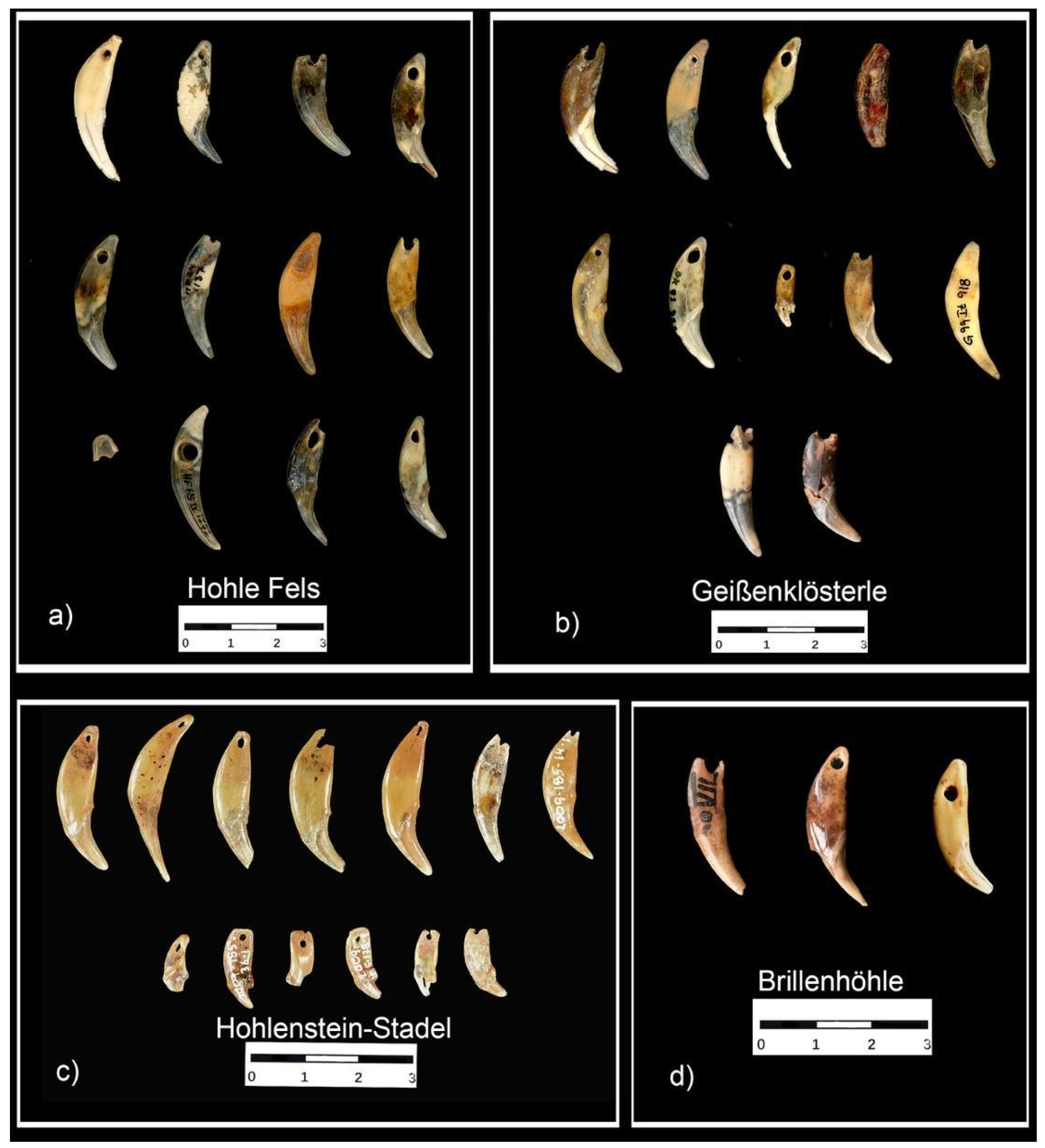
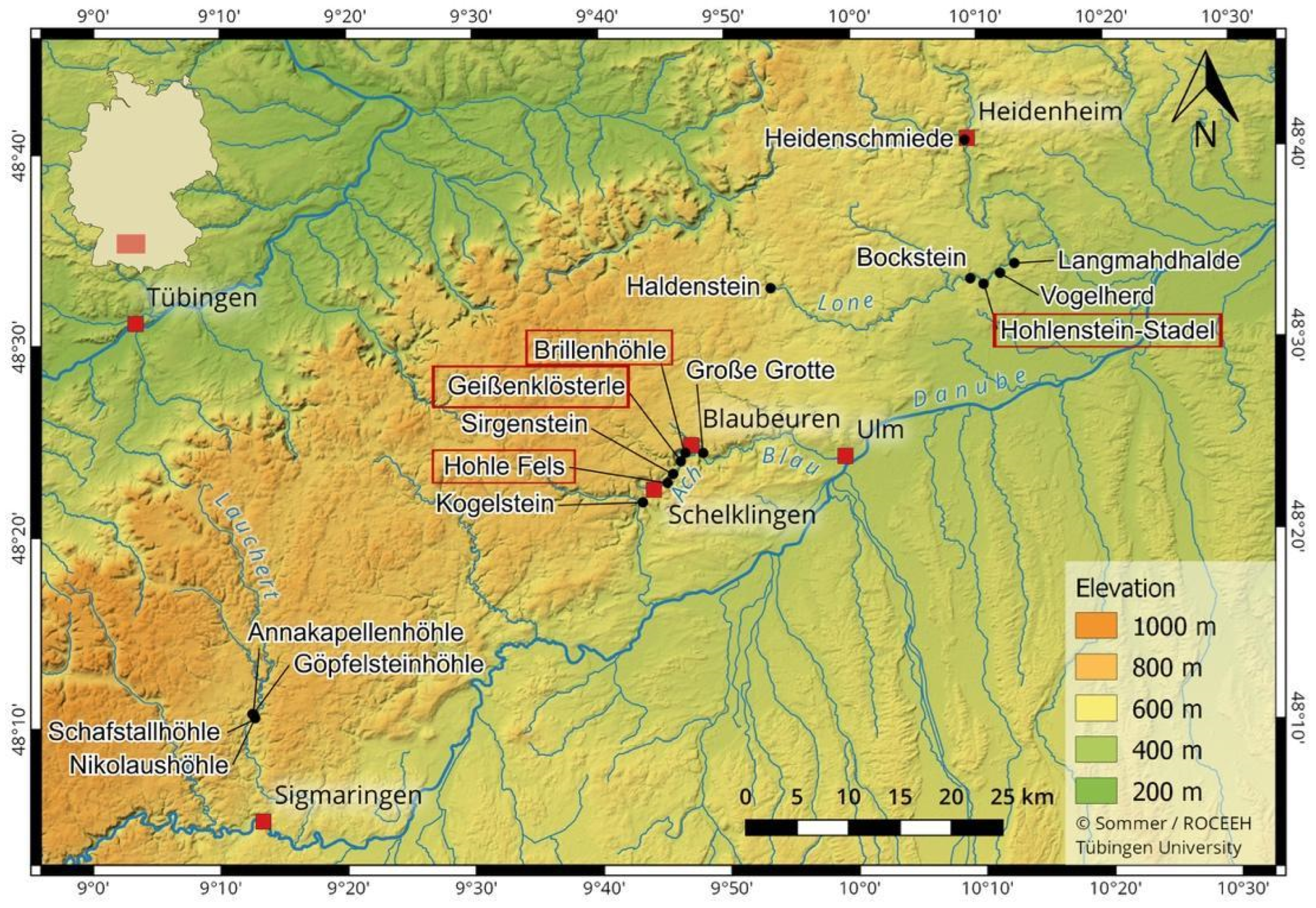
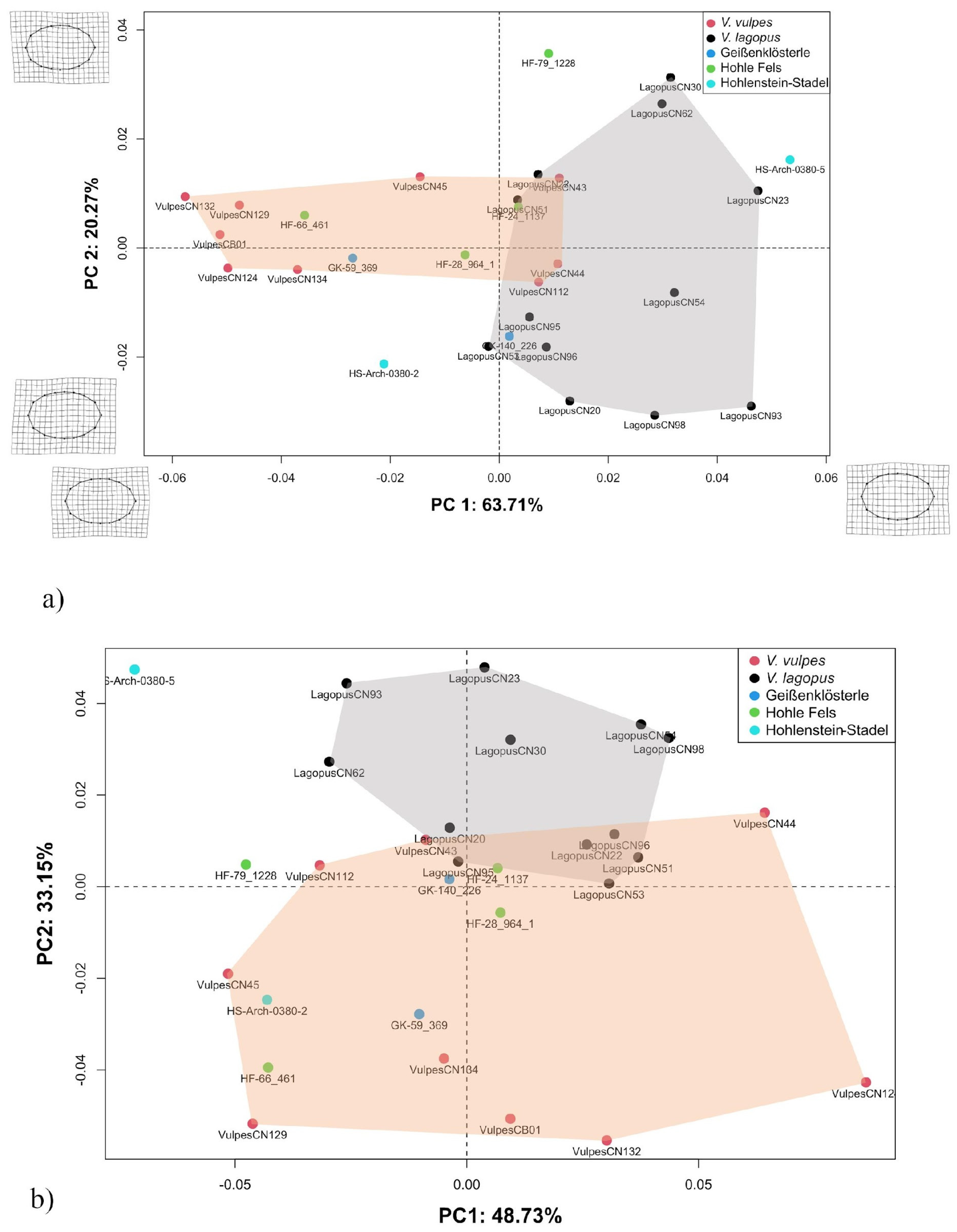
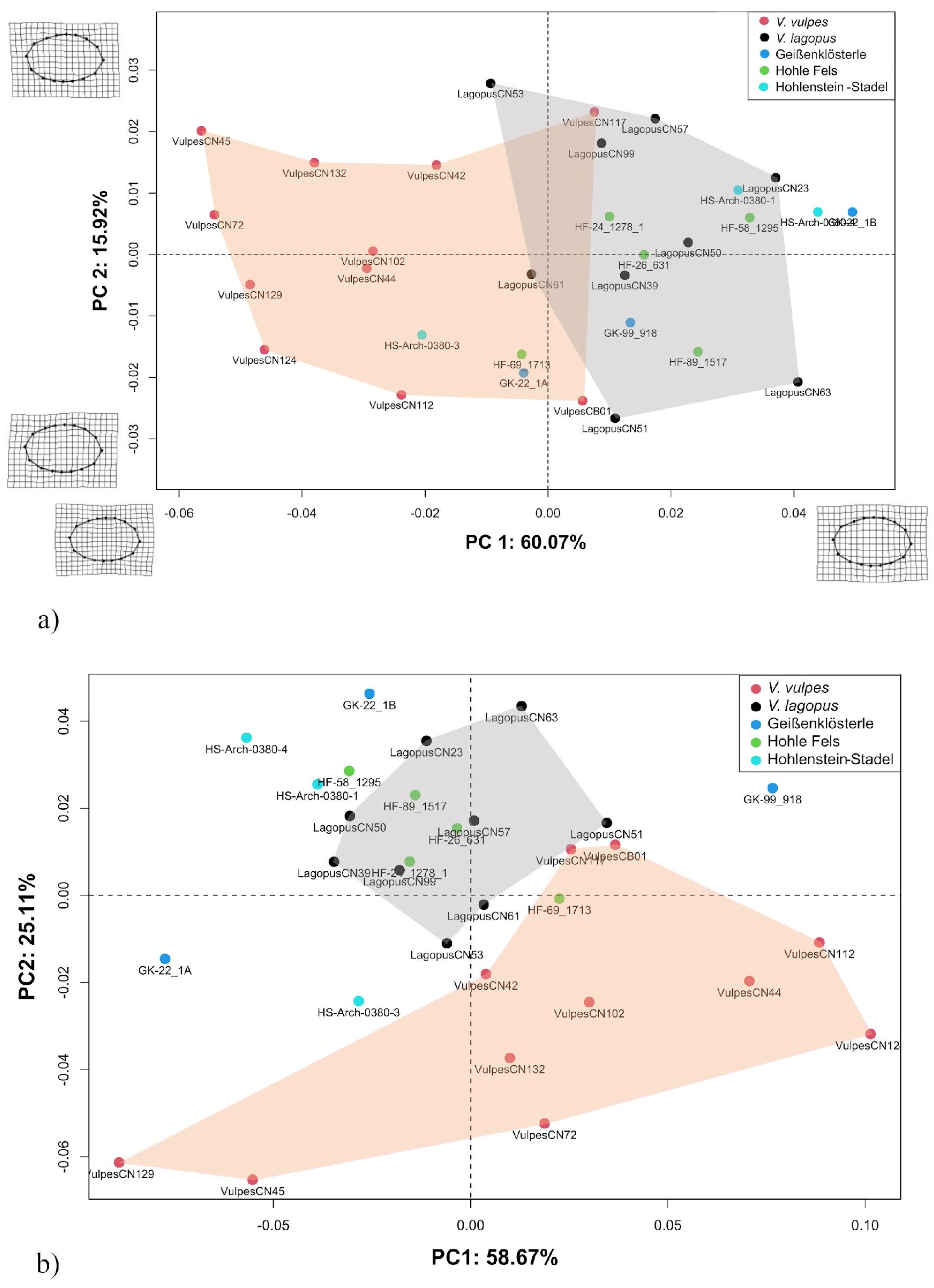
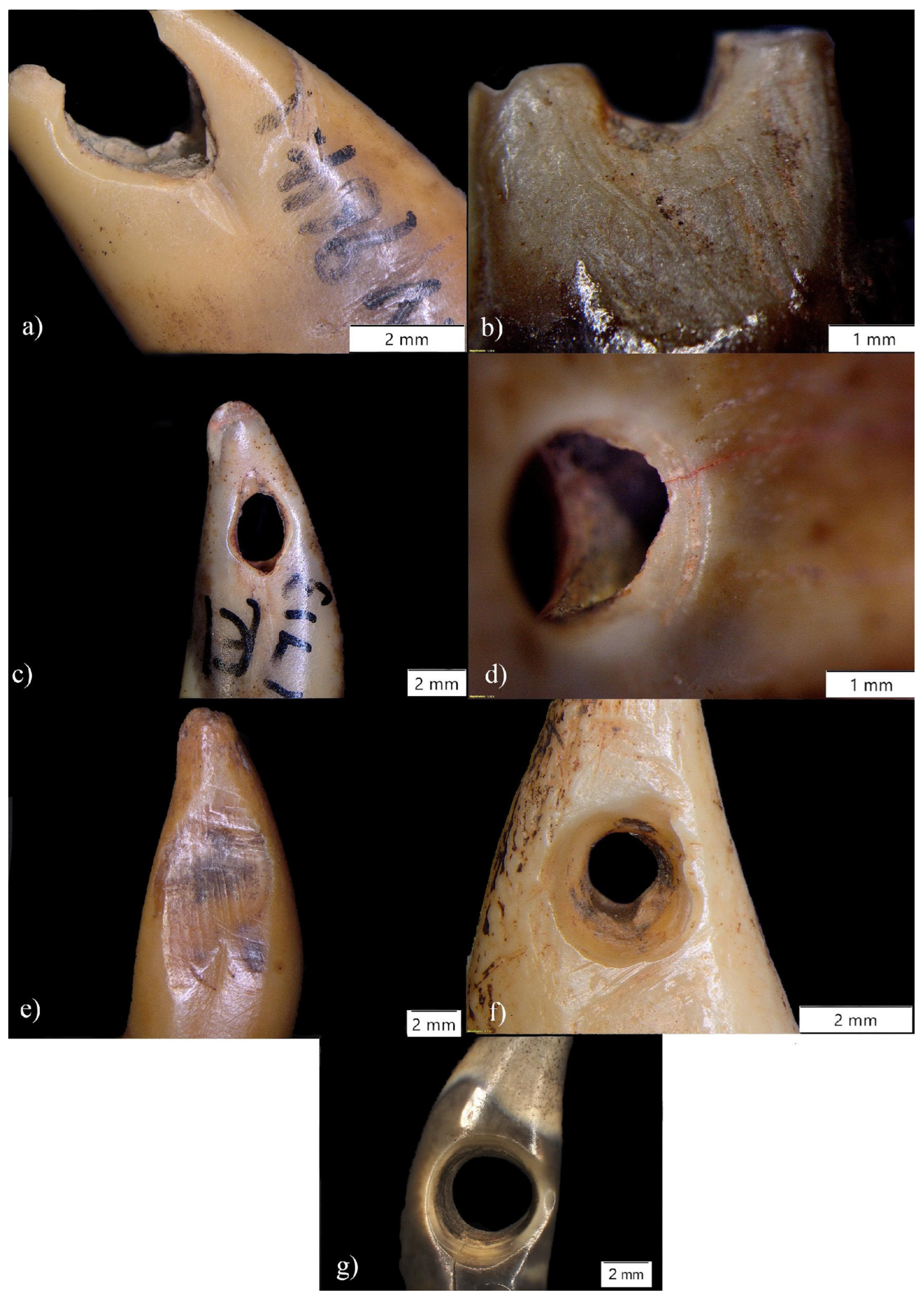
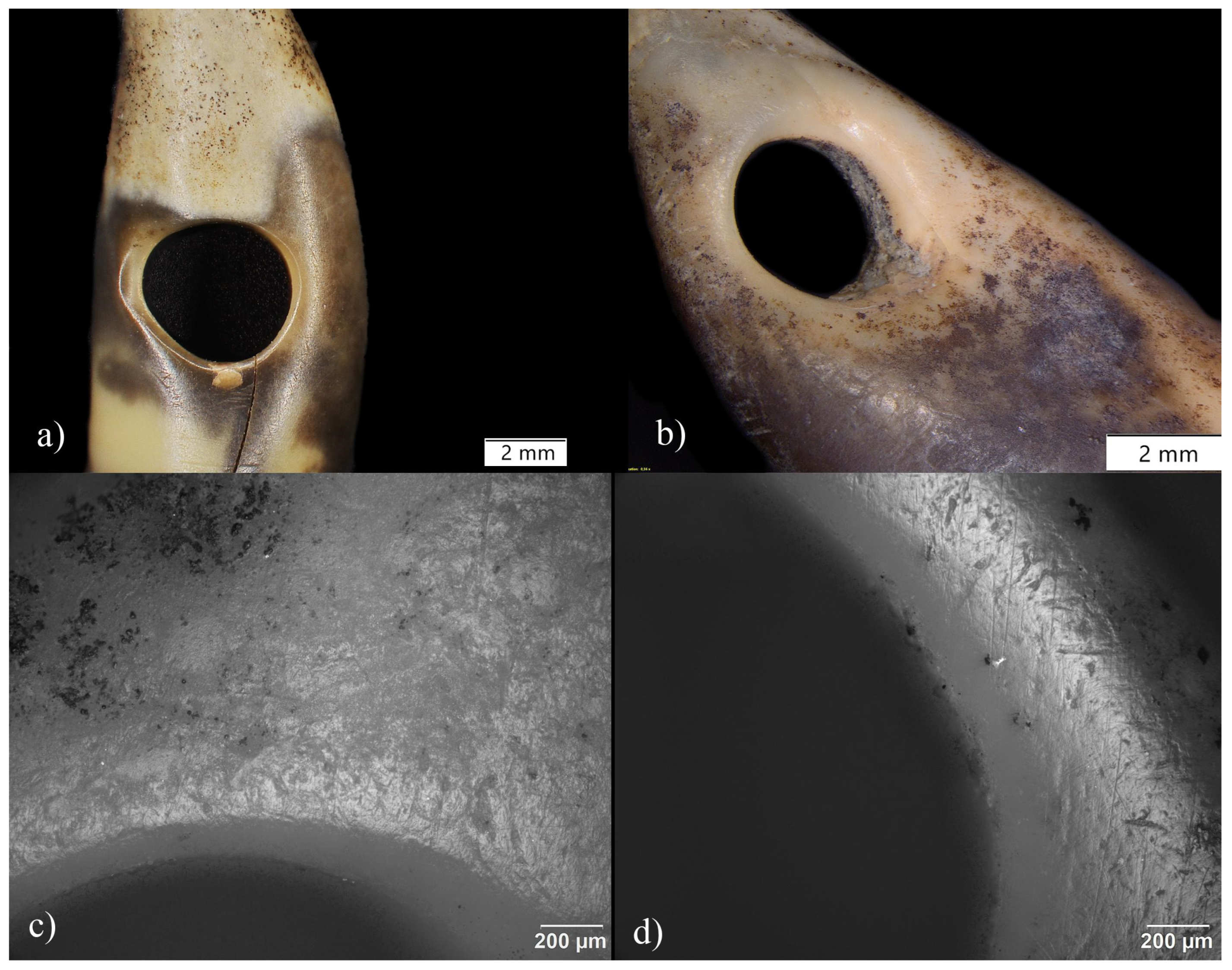
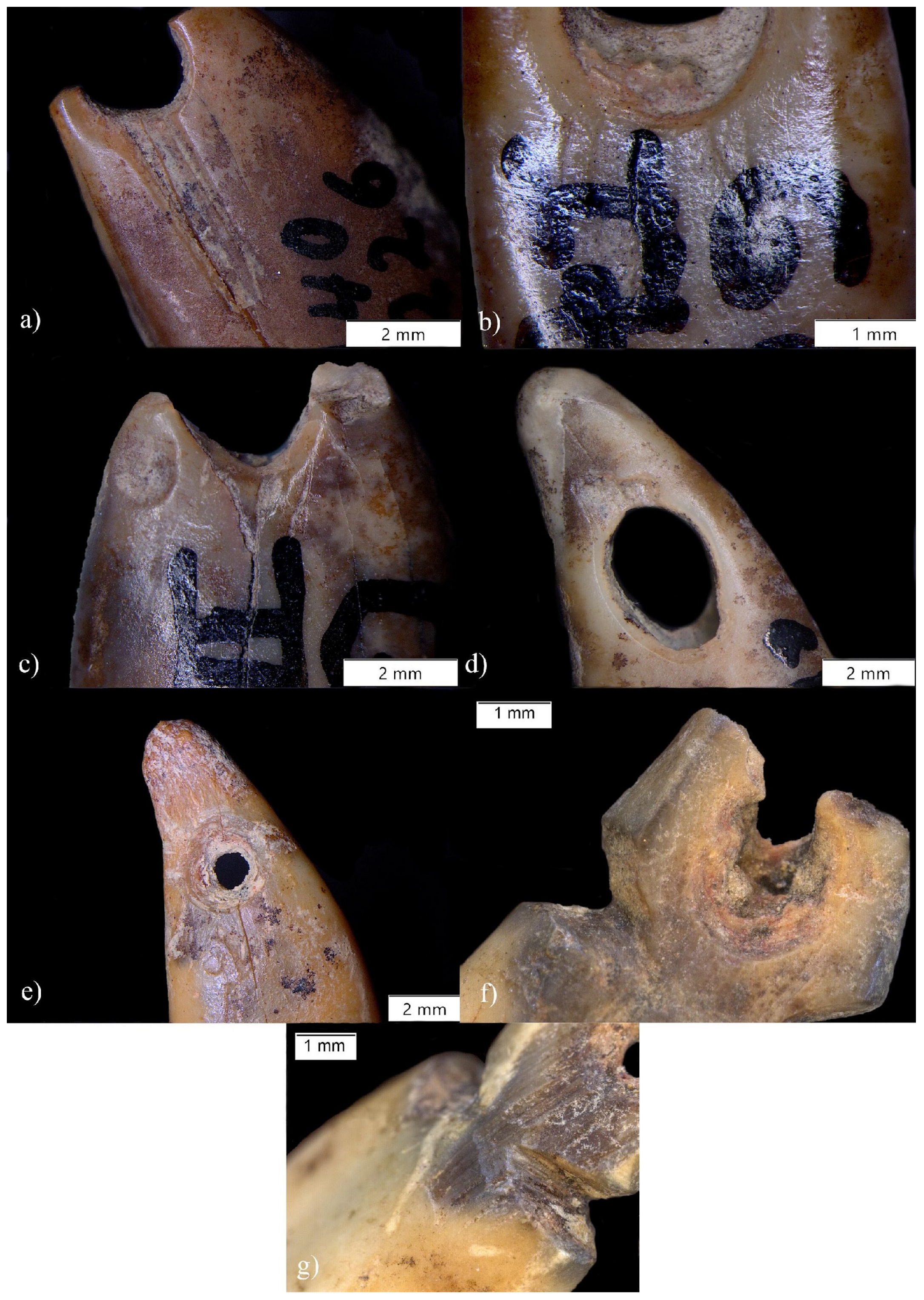
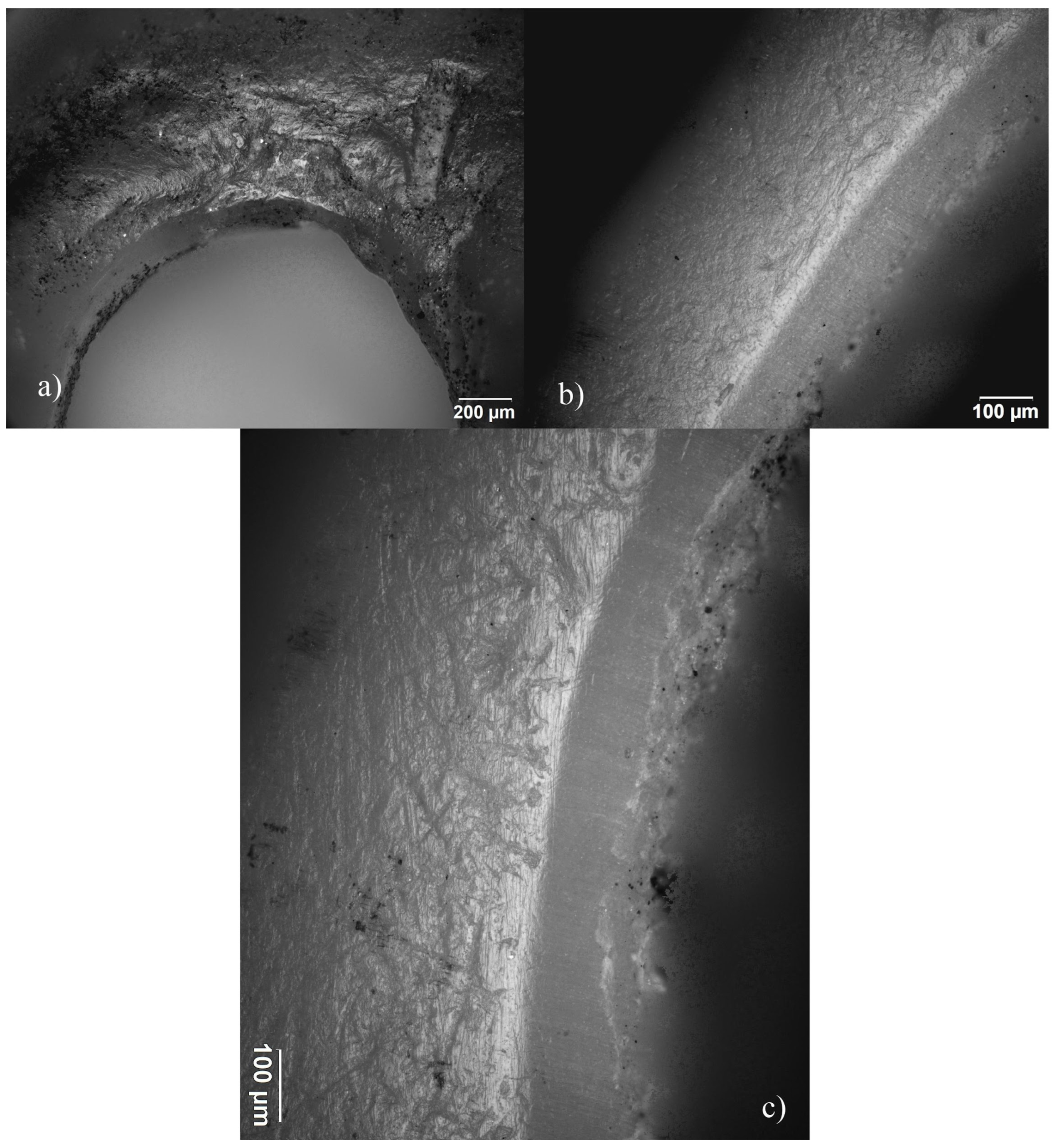
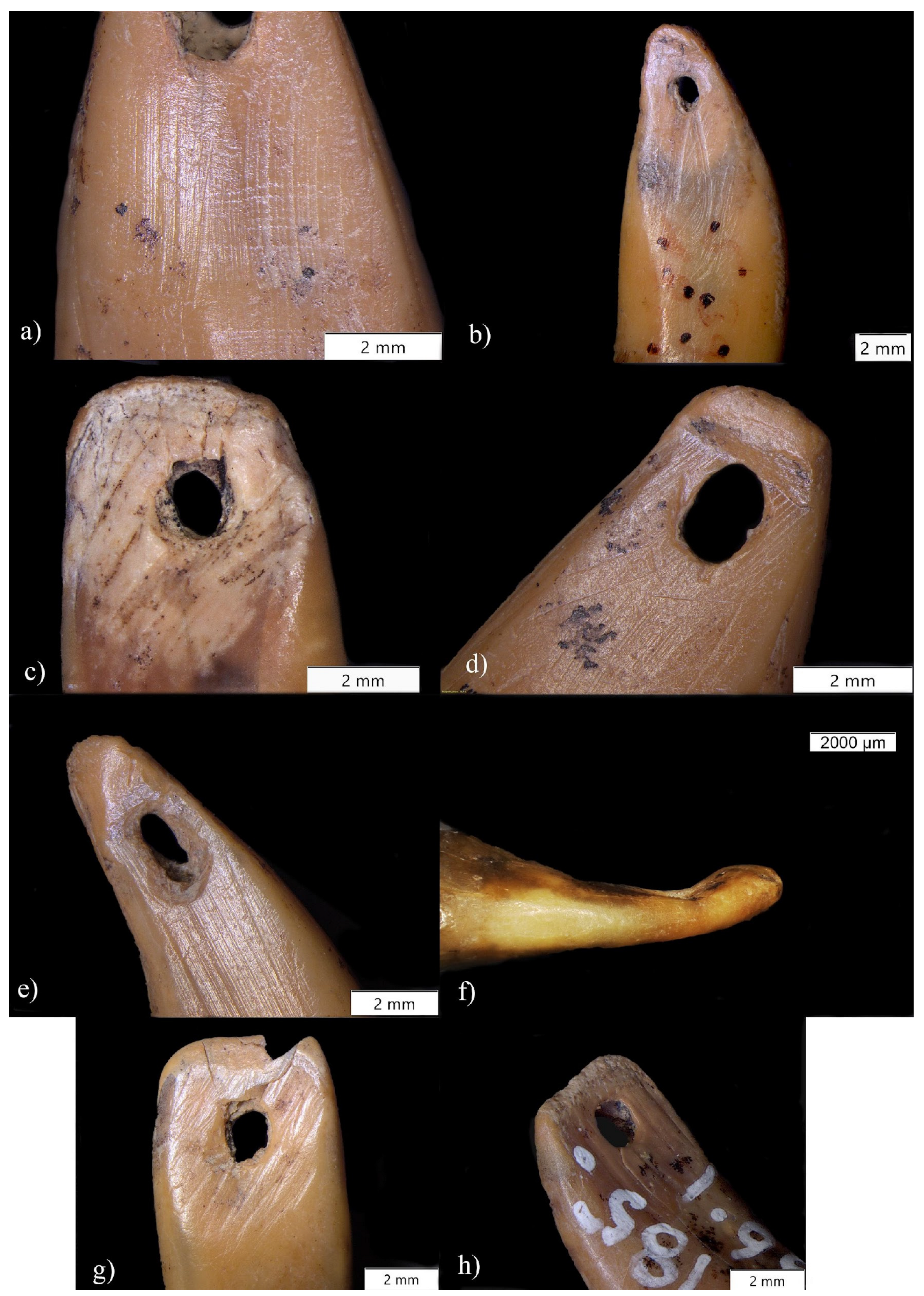
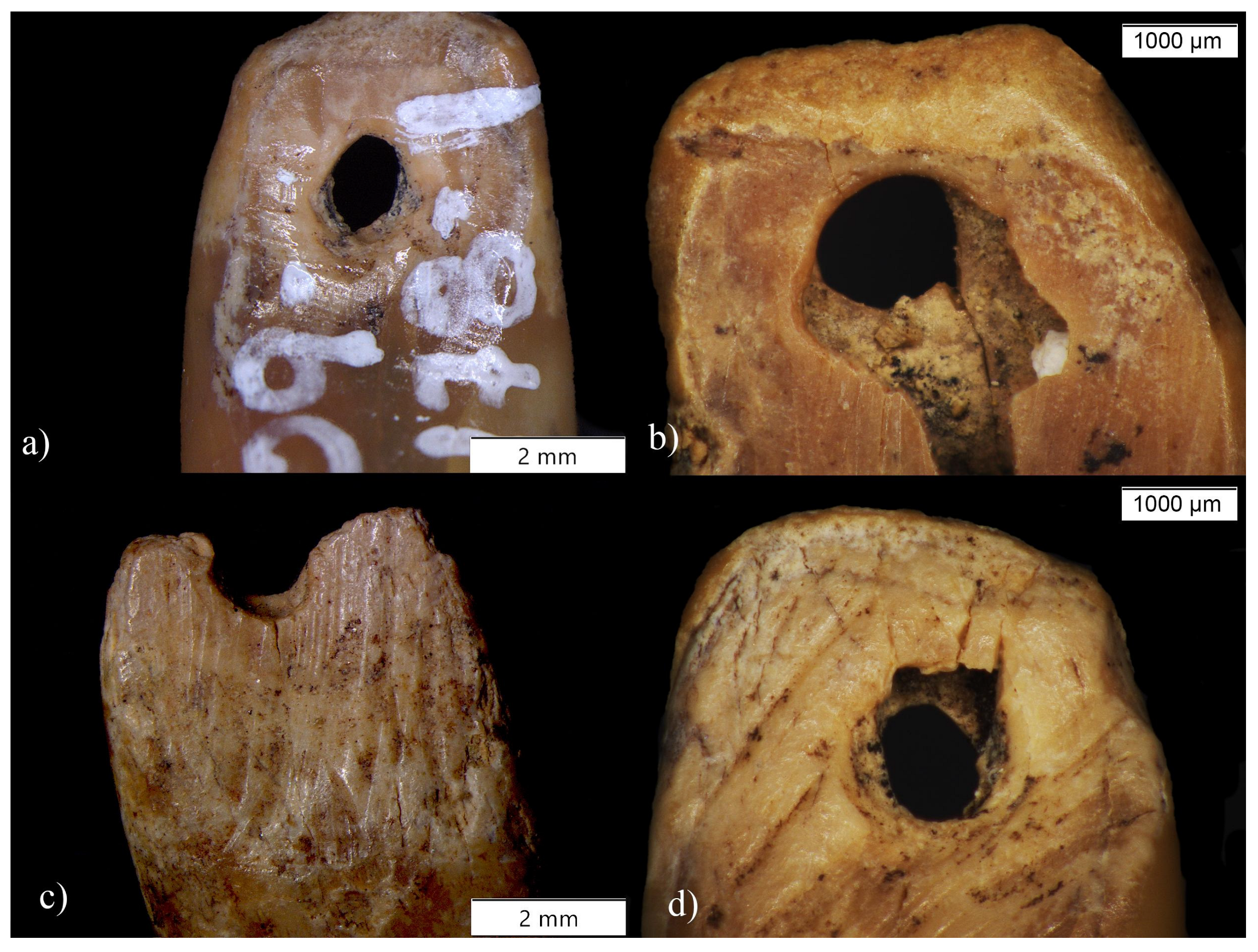
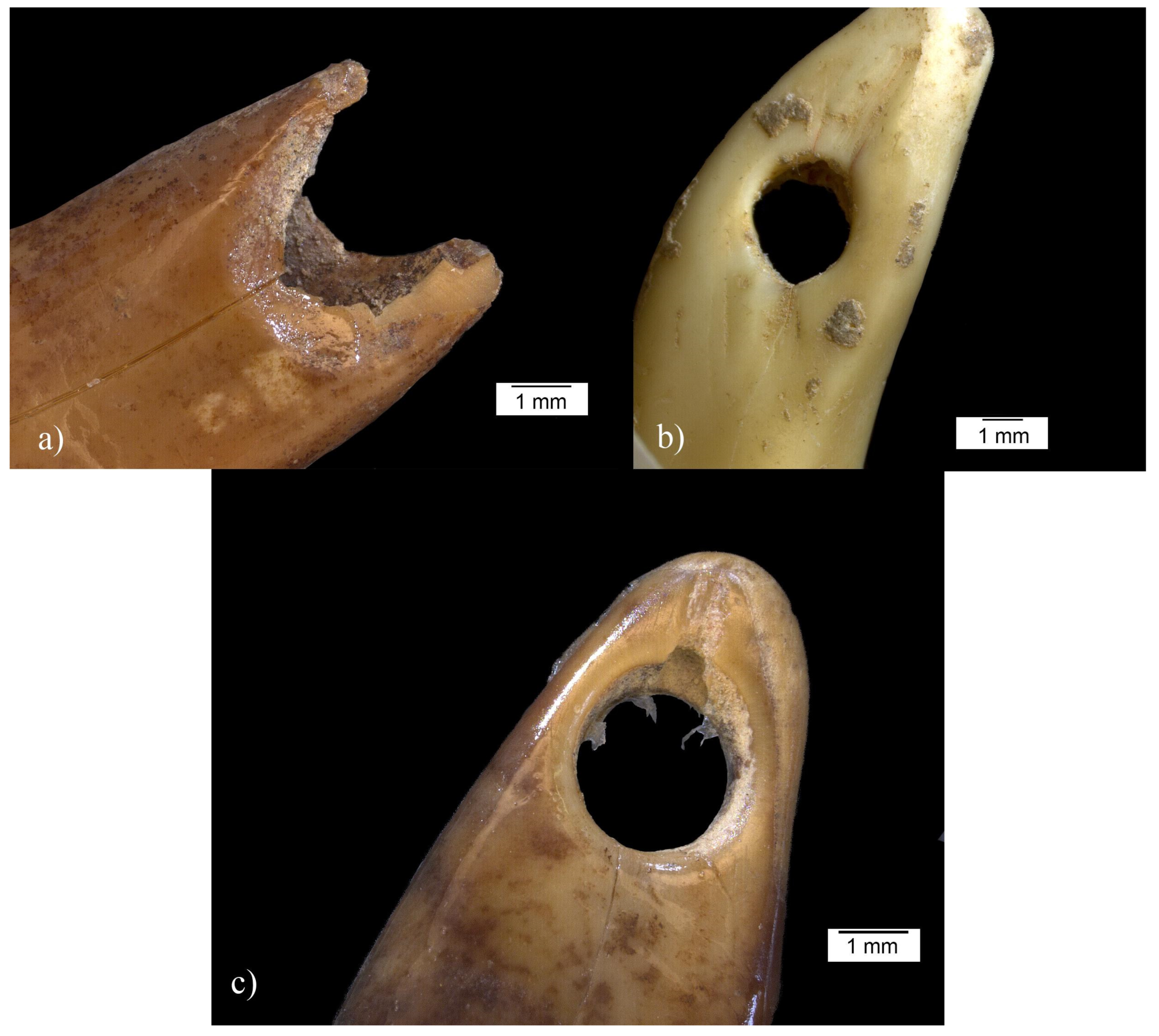
| Culture | QU | ID | GH | AH | Species ID (Morph) | Species ID (GM) | Tooth |
|---|---|---|---|---|---|---|---|
| Hohle Fels: | |||||||
| NA (Upper Paleolithic) | 28 | 964.1 | 1ka-7 | 0/I-IV | Vulpes sp. | Vulpes vulpes | Canine |
| Gravettian | 58 | 1295 | 3c | IIc | Vulpes lagopus 1 | Vulpes lagopus | Canine |
| Gravettian | 79 | 1228.29 | 3c-3d | IIc-IId | Vulpes sp. | Vulpes lagopus | Canine |
| Gravettian | 66d | 461 | 3bl | IIb | Vulpes sp. 1 | Vulpes vulpes | Canine |
| Aurignacian-Gravettian | 76 | 1227.1 | 5 | IIe | Vulpes sp. ? | NA | Root fragment |
| Aurignacian-Gravettian | 59 | 2099.1 | 5-7 | IIe-IV | Vulpes lagopus 1 | NA | Canine |
| Aurignacian | 24 | 1137 | 7 | IV | Vulpes sp. | Indeterminate | Canine |
| Aurignacian | 26 | 631.1 | 7a | Va | Vulpes sp. | Vulpes lagopus | Canine |
| Aurignacian | 69 | 1713 | 7 | IV | Vulpes lagopus 1 | Vulpes vulpes? | Canine |
| Aurignacian | 89 | 1517.1 | 7 | IV | Vulpes sp. | Vulpes lagopus | Canine |
| Aurignacian | 24 | 1278.1 | 7 | IV | Vulpes sp. | Vulpes lagopus | Canine |
| Aurignacian | 65 | 1742 | 7 | IV | Vulpes sp. | NA | Canine |
| Geißenklösterle: | |||||||
| NA (likely Gravettian) | 22 | 1A | disturbed | disturbed | Vulpes sp. | Vulpes vulpes ? | Canine |
| NA (likely Gravettian) | 22 | 1B | disturbed | disturbed | Vulpes sp. | Vulpes lagopus | Canine |
| Gravettian | 67 | 658.2 | 7 | It | Vulpes sp. | NA | Incisor |
| Gravettian | 98 | 391 | 7 | It | Vulpes sp. | Vulpes vulpes | Canine |
| Gravettian | 99 | 918 | 7 | It | Vulpes sp. | Vulpes lagopus ? | Canine |
| Gravettian | 100 | 89 | 5b | Ir | Vulpes sp. 1 | Vulpes sp. | Canine |
| Gravettian | 140 | 226 | 7 | It | Vulpes sp. | Vulpes lagopus | Canine |
| Gravettian | 98 | 286 | 7 | It | Vulpes sp. | NA | Canine |
| Gravettian | 98 | 387 | 7 | It | Vulpes lagopus 1 | NA | Canine |
| Aurignacian | 59 | 369 | 16 | IIIb | Vulpes sp. 1 | Vulpes vulpes | Canine |
| Aurignacian | 58 | 487 | 15 | III | Vulpes sp. | NA | Canine |
| Aurignacian | 67 | 1511 | 15 | IIIa | Vulpes sp. | NA | Canine |
| Hohlenstein-Stadel: | |||||||
| Aurignacian | NA | 1.0380 | 19./20. Meter, 6. Hieb | NA | Vulpes sp. | Vulpes lagopus | Canine |
| Aurignacian | NA | 2.0380 | 19./20. Meter, 6. Hieb | NA | Vulpes sp. | Vulpes vulpes | Canine |
| Aurignacian | NA | 3.0380 | 19./20. Meter, 6. Hieb | NA | Vulpes sp. | Vulpes vulpes | Canine |
| Aurignacian | NA | 4.0380 | 19./20. Meter, 6. Hieb | NA | Vulpes sp. | Vulpes lagopus | Canine |
| Aurignacian | NA | 5.0380 | 19./20. Meter, 6. Hieb | NA | Vulpes sp. | Vulpes lagopus | Canine |
| Aurignacian or Magdalenian | NA | 36-1 | backdirt | NA | Vulpes sp. | NA | Incisor |
| Aurignacian or Magdalenian | NA | 90001-1 | backdirt | NA | Vulpes sp. | NA | Incisor |
| Aurignacian or Magdalenian | NA | 9000-1 | backdirt | NA | Vulpes sp. | NA | Incisor |
| Aurignacian or Magdalenian | NA | 14-1 | backdirt | NA | Vulpes sp. | Vulpes sp. | Canine |
| Aurignacian or Magdalenian | NA | 141-1 | backdirt | NA | Vulpes sp. | Vulpes sp. | Canine |
| Aurignacian or Magdalenian | NA | 178-1 | backdirt | NA | Vulpes sp. | NA | Premolar |
| Aurignacian or Magdalenian | NA | 33-1 | backdirt | NA | Vulpes sp. | NA | Premolar |
| Aurignacian or Magdalenian | NA | 167-1 | backdirt | NA | Vulpes sp. ? | NA | Root fragment |
| Brillenhöhle: | |||||||
| Gravettian | NA | 132 | NA | VII | Vulpes sp. | NA | Canine |
| Gravettian | P7 | 131 | NA | VII | Vulpes sp. | NA | Canine |
| Gravettian | NA | 130 | NA | VII | Vulpes sp. | NA | Canine |
| Site | Red Fox | Arctic Fox | Indeterminate | Unsuitable for Analysis |
|---|---|---|---|---|
| Geißenklösterle (n = 7) | 2 | 3 | 0 | 2 |
| Hohle Fels (n = 10) | 3 | 4 | 2 | 1 |
| Hohlenstein-Stadel (n = 7) | 2 | 3 | 0 | 2 |
| Total (n = 24) | 7 | 10 | 2 | 5 |
| Site | Culture | Find Number (ID) | Tooth | Integrity of Perforation | Technique of Perforation | Use Traces |
|---|---|---|---|---|---|---|
| Hohle Fels | Aurignacian | 1517.1 | Canine | Complete | Scraping + grooving + drilling | Used: rounding/ smoothing |
| Hohle Fels | Aurignacian | 1137 | Canine | Fragmentary | Scraping | Not diagnostic |
| Hohle Fels | Aurignacian | 631.1 | Canine | Complete | Probably scraping + widening | Not diagnostic |
| Hohle Fels | Aurignacian | 1713 | Canine | Complete | Scraping + grooving + widening | Used: rounding/smoothing/Polish and striae |
| Hohle Fels | Aurignacian | 1278.1 | Canine | Complete (broke during analysis) | Scraping + grooving | Used: rounding/ smoothing |
| Hohle Fels | Aurignacian | 1742 | Canine | Complete | Drilling | Used: rounding/ smoothing |
| Hohle Fels | Aurignacian-Gravettian | 2099.1 | Canine | Complete | Scraping + grooving | Possibly used |
| Hohle Fels | Gravettian | 1295 | Canine | Complete | Scraping + grooving+ possibly widening | Used: rounding/smoothing/Polished |
| Hohle Fels | Gravettian | 1228.29 | Canine | Perforation unaccomplished | Carving + Scraping + grooving | Not Used |
| Hohle Fels | Aurignacian-Gravettian | 1227.1 | Root fragment | Fragmentary | NA | NA |
| Hohle Fels | Gravettian | 461 | Canine | Complete | Scraping + drilling | Used: rounding/ smoothing |
| Hohle Fels | NA | 964.1 | Canine | Fragmentary | Scraping + grooving | Not diagnostic |
| Site | Culture | Find Number (ID) | Tooth | Integrity of Perforation | Technique of Perforation | Use Traces |
|---|---|---|---|---|---|---|
| Geißenklösterle | Aurignacian | 487 | Canine | Fragmentary | Scraping + drilling/lateral carving | Not eligible |
| Geißenklösterle | Aurignacian | 1511 | Canine | Fragmentary | Possibly scraped + widening | Not eligible |
| Geißenklösterle | Aurignacian | 369 | Canine | Fragmentary | Grooving | Not diagnostic |
| Geißenklösterle | most likely Gravettian | 1A | Canine | Fragmentary | Gouging + widening | Not diagnostic |
| Geißenklösterle | most likely Gravettian | 1B | Canine | Complete | Scraping + drilling | Not diagnostic |
| Geißenklösterle | Gravettian | 391 | Canine | Complete | Grooving + Carving | Used: rounding/polish/striae (lateral sides) |
| Geißenklösterle | Gravettian | 918 | Canine | Non-human modified | / | |
| Geißenklösterle | Gravettian | 658.2 | Incisor (?) | Complete | Light scraping + possibly widening | Used: rounding/smoothing/Polish (apex) |
| Geißenklösterle | Gravettian | 89 | Canine | Not preserved | NA | NA |
| Geißenklösterle | Gravettian | 226 | Canine | Fragmentary | Scraping + grooving | Not diagnostic |
| Geißenklösterle | Gravettian | 387 | Canine | Complete | Possibly scraping + widening | Used: rounding/polish/striae (lateral sides) |
| Geißenklösterle | Gravettian | 286 | Canine | Complete | Scraping/grooving + widening | Not diagnostic |
| Site | Culture | Find Number (ID) | Tooth | Integrity of Perforation | Technique of Perforation | Use Traces |
|---|---|---|---|---|---|---|
| Hohlenstein-Stadel | Aurignacian | 1.0380 | Canine | Complete | Scraping + widening | Most likely used: rounding |
| Hohlenstein-Stadel | Aurignacian | 2.0380 | Canine | Complete | Scraping + carving | Most likely used: rounding |
| Hohlenstein-Stadel | Aurignacian | 3.0380 | Canine | Complete | Scraping | Most likely used: rounding |
| Hohlenstein-Stadel | Aurignacian | 4.0380 | Canine | Fragmentary | Scraping + grooving | Not diagnostic |
| Hohlenstein-Stadel | Aurignacian | 5.0380 | Canine | Complete | Scraping | Not diagnostic |
| Hohlenstein-Stadel | Aurignacian or Magdalenian | 14.1 | Canine | Fragmentary | Grooving | Not diagnostic |
| Hohlenstein-Stadel | Aurignacian or Magdalenian | 141.1 | Canine | Fragmentary | Scraping + possibly widening | Not diagnostic |
| Hohlenstein-Stadel | Aurignacian or Magdalenian | 167.1 | Root fragment | Complete | Possibly abrasion/scraping + widening | Most likely used: rounding |
| Hohlenstein-Stadel | Aurignacian or Magdalenian | 178.1 | Premolar | Complete | Possibly abrasion/scraping + widening | Most likely used: rounding |
| Hohlenstein-Stadel | Aurignacian or Magdalenian | 33.1 | Premolar | Complete | Carving + widening | Most likely used: rounding |
| Hohlenstein-Stadel | Aurignacian or Magdalenian | 36.1 | Incisor (?) | Complete | Possibly abrasion/scraping + widening | Used: rounding/ smoothing |
| Hohlenstein-Stadel | Aurignacian or Magdalenian | 9000.1 | Incisor (?) | Complete | Possibly abrasion/scraping + possibly widening | Most likely used: rounding |
| Hohlenstein-Stadel | Aurignacian or Magdalenian | 9001.1 | Incisor (?) | Fragmentary | Possibly abrasion/scraping + possibly widening | Not diagnostic |
| Site | Culture | Find Number (ID) | Tooth | Integrity of Perforation | Technique of Perforation | Use Traces on Perforation |
|---|---|---|---|---|---|---|
| Brillenhöhle | Gravettian | 132 | Canine | Complete | Grooving/carving + widening | Most likely used: rounding/smoothing |
| Brillenhöhle | Gravettian | 131 | Canine | Complete | Scraping/grooving + widening or drilling | Most likely used: rounding/smoothing |
| Brillenhöhle | Gravettian | 130 | Canine | Fragmentary | Scraping + grooving | Not diagnostic |
Disclaimer/Publisher’s Note: The statements, opinions and data contained in all publications are solely those of the individual author(s) and contributor(s) and not of MDPI and/or the editor(s). MDPI and/or the editor(s) disclaim responsibility for any injury to people or property resulting from any ideas, methods, instructions or products referred to in the content. |
© 2023 by the authors. Licensee MDPI, Basel, Switzerland. This article is an open access article distributed under the terms and conditions of the Creative Commons Attribution (CC BY) license (https://creativecommons.org/licenses/by/4.0/).
Share and Cite
Venditti, F.; McCartin, M.J.; Ostermann, M.-L.; Conard, N.J.; Wolf, S. Foxes in Retrospect—Unraveling Human-Fox Relationships through Fox Tooth Ornaments in the Swabian Jura. Quaternary 2023, 6, 50. https://doi.org/10.3390/quat6030050
Venditti F, McCartin MJ, Ostermann M-L, Conard NJ, Wolf S. Foxes in Retrospect—Unraveling Human-Fox Relationships through Fox Tooth Ornaments in the Swabian Jura. Quaternary. 2023; 6(3):50. https://doi.org/10.3390/quat6030050
Chicago/Turabian StyleVenditti, Flavia, Madison J. McCartin, Melanie-Larisa Ostermann, Nicholas J. Conard, and Sibylle Wolf. 2023. "Foxes in Retrospect—Unraveling Human-Fox Relationships through Fox Tooth Ornaments in the Swabian Jura" Quaternary 6, no. 3: 50. https://doi.org/10.3390/quat6030050
APA StyleVenditti, F., McCartin, M. J., Ostermann, M.-L., Conard, N. J., & Wolf, S. (2023). Foxes in Retrospect—Unraveling Human-Fox Relationships through Fox Tooth Ornaments in the Swabian Jura. Quaternary, 6(3), 50. https://doi.org/10.3390/quat6030050






